
Executive
Director’s
Message
“Now, more than ever, we must press for the change we know is possible and vital to the success of women business owners and our global economy.”
Thirty-four years ago, existing and aspiring women business owners and their supporters
took a stand. Together, they determined that women entrepreneurs deserved equal access to
entrepreneurial resources, nondiscriminatory funding, and contracting opportunities,
attaining that first milestone with the signing
of H.R. 5050—the Women’s Business Ownership Act—into law. Today, H.R. 5050 continues to
represent the power of our collective voices at work and serves as an important reminder
not only of our shared legacy, but also of the urgent need for new breakthrough ideas and
collaborative energy critical to fighting systemic discrimination and to championing
legislation and tailored programs that support the needs of all U.S. women business
owners.
That is why it is of significant importance that we have prioritized rebuilding the
Council with powerful women who have their ears to the ground and are closest to the
issues impacting entrepreneurs nationwide. We are confident that our Council Members’
insights, as well as the strength and ingenuity of our combined networks,
will further the Council’s goals in the year ahead. This includes influencing policy to
change certain lending criteria that are inherently stacked against women of color,
building a stronger coalition of collaborators working toward gender parity across federal
programs, and ensuring engagement and customized supports for the betterment of diverse
women entrepreneurs in communities across the country. As we continue to navigate the
after-effects of the pandemic, it has become apparent that the work of this Council—the
various meetings, policy roundtables, research, and the sharing of our collective
experiences and deliberations—will continue to build momentum. This is no time to slow
down. In fact, now, more than ever, we must press for the change we know is possible and
vital to the success of women business owners and our global economy.
President Biden’s budgetary commitments to women business owners set the precedence for the work ahead of us. We are encouraged by this bold stance to bolster services for women and other underserved entrepreneurs by expanding current programs and supporting innovative initiatives to foster economic resiliency. I have no doubt that our new Council of power players will continue to seize the opportunity and help define how this commitment connects to women-owned enterprises, as more and more shift from “the pivot” and recovery to growth. It is a privilege to help harness this Council’s expertise and energy, with the support of the NWBC Team, to help bring about meaningful change for today’s women business owners and the next generation of women entrepreneurs.


Executive
Director’s
Message
“Now, more than ever, we must press for the change we know is possible and vital to the success of women business owners and our global economy.”
Thirty-four years ago, existing and aspiring women business owners and their supporters
took a stand. Together, they determined that women entrepreneurs deserved equal access to
entrepreneurial resources, nondiscriminatory funding, and contracting opportunities,
attaining that first milestone with the signing
of H.R. 5050—the Women’s Business Ownership Act—into law. Today, H.R. 5050 continues to
represent the power of our collective voices at work and serves as an important reminder
not only of our shared legacy, but also of the urgent need for new breakthrough ideas and
collaborative energy critical to fighting systemic discrimination and to championing
legislation and tailored programs that support the needs of all U.S. women business
owners.
That is why it is of significant importance that we have prioritized rebuilding the
Council with powerful women who have their ears to the ground and are closest to the
issues impacting entrepreneurs nationwide. We are confident that our Council Members’
insights, as well as the strength and ingenuity of our combined networks,
will further the Council’s goals in the year ahead. This includes influencing policy to
change certain lending criteria that are inherently stacked against women of color,
building a stronger coalition of collaborators working toward gender parity across federal
programs, and ensuring engagement and customized supports for the betterment of diverse
women entrepreneurs in communities across the country. As we continue to navigate the
after-effects of the pandemic, it has become apparent that the work of this Council—the
various meetings, policy roundtables, research, and the sharing of our collective
experiences and deliberations—will continue to build momentum. This is no time to slow
down. In fact, now, more than ever, we must press for the change we know is possible and
vital to the success of women business owners and our global economy.
President Biden’s budgetary commitments to women business owners set the precedence for the work ahead of us. We are encouraged by this bold stance to bolster services for women and other underserved entrepreneurs by expanding current programs and supporting innovative initiatives to foster economic resiliency. I have no doubt that our new Council of power players will continue to seize the opportunity and help define how this commitment connects to women-owned enterprises, as more and more shift from “the pivot” and recovery to growth. It is a privilege to help harness this Council’s expertise and energy, with the support of the NWBC Team, to help bring about meaningful change for today’s women business owners and the next generation of women entrepreneurs.

Table of
Contents
History, Mission
AND STRUCTURE
History, Mission
AND STRUCTURE
History, Mission
AND STRUCTURE
History
The National Women’s Business Council (“NWBC” or “the Council”) was created under Title IV of H.R. 5050: The Women’s Business Ownership Act of 1988, as amended (U.S.C. § 7105, et seq.). H.R. 5050 was authored by Congressman John LaFalce (D-NY) and signed into law by President Ronald Reagan. NWBC operates in accordance with the Federal Advisory Committee Act (FACA).
A landmark piece of legislation, H.R. 5050 also:

Mission
NWBC is an independent, nonpartisan federal advisory committee housed within the U.S. Small Business Administration (SBA). It is made up of 15 volunteers who are all prominent women business owners and leaders of national women’s business organizations. The Council’s core mission is to provide advice and annual policy recommendations to the President, Congress, and the SBA Administrator on issues of importance to women business owners.
NWBC’s statutory obligations include:
STRUCTURE
Fifteen Council Members serve three-year terms:
One Presidentially appointed Chair.
Four small business owners serve from the President’s political party.
Four small business owners serve from parties other than the President’s.
Six women leaders serve from women’s business organizations.
COUNCIL MEMBERS:
Small Business Owners

Maria Rios
President and Chief
Executive
Officer of Nation Waste, Inc.
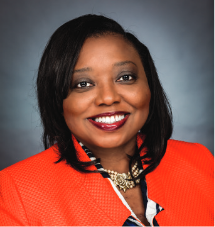
Selena Rodgers Dickerson
Founder
of SARCOR, LLC
Business Organizations
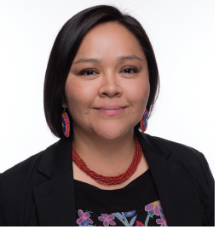
Jaime Gloshay
Cofounder and
Codirector of Native Women Lead (NWL)

Dr. Shakenna Williams
Executive
Director of the Center for Women’s Entrepreneurial Leadership (CWEL) and Founder
of Black Women’s Enterpreneurial Leadership (BWEL)
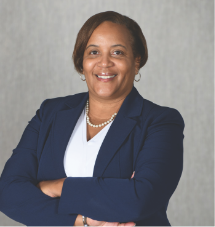
Roberta McCullough
Board Chair of
the Association of Women’s Business Centers (AWBC)
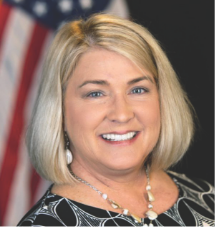
Pamela Prince-Easton
President and
Chief Executive officer of Women’s Business Enterprise National Council (WBENC)
By The
NUMBERS
By The
NUMBERS
By The
NUMBERS
By The
NUMBERS
By The
NUMBERS
By The
NUMBERS
INTRODUCTION
The economic landscape for women entrepreneurs is constantly evolving. “By The Numbers” captures the state of affairs during the past year, and what may lie ahead during the next few. The first section, a general overview, is based on research findings from Adji Fatou Diagne, PhD, a research economist with the Center for Economic Studies at the U.S. Census Bureau. She presented these research findings to the Council and the public during NWBC’s May public meeting.
The second section focuses on the dynamics at play in venture capital for women founders, investors, and fund managers, based on the work of Geri Stengel, President of Ventureneer. Her analysis was conducted as part of a report entitled “How Women (and Men) Invest In Startups,” which was produced by Ventureneer and CoreWoman and commissioned by How Women Invest.
INTRODUCTION
The economic landscape for women entrepreneurs is constantly evolving. “By The Numbers” captures the state of affairs during the past year, and what may lie ahead during the next few. The first section, a general overview, is based on research findings from Adji Fatou Diagne, PhD, a research economist with the Center for Economic Studies at the U.S. Census Bureau.She presented these research findings to the Council and the public during NWBC’s May public meeting. The second section focuses on the dynamics at play in venture capital for women founders, investors, and fund managers, based on the work of Geri Stengel, President of Ventureneer. Her analysis was conducted as part of a report entitled “How Women (and Men) Invest In Startups,” whichwas produced by Ventureneer and CoreWoman and commissioned by How Women Invest.
The second section focuses on the dynamics at play in venture capital for women founders, investors, and fund managers, based on the work of Geri Stengel, President of Ventureneer. Her analysis was conducted as part of a report entitled “How Women (and Men) Invest In Startups,” whichwas produced by Ventureneer and CoreWoman and commissioned by How Women Invest.
THE STATE OF WOMEN-OWNED BUSINESSES
Most Recent Statistics and Growth
Women contribute substantially to entrepreneurship in the United States. The number of
women-owned
businesses has increased significantly in recent years. In 2019 (latest data available),
there were 5.7 million employer businesses where women accounted for 1.2 million or 20.9%
of these businesses.1 Women-employer firms grew 16.7% between 2012 and 2019
compared to the 5.2% growth rate for men-owned firms during this period (see figure
below). Gross receipts for women-owned employer businesses increased exponentially (51.9%)
between 2012 and 2019 while revenues for men rose 34.2%. Women-owned firms employed 10.8
million workers in 2019 and grew their workforce by 28%, more than double that of
men-owned firms (10.8%) between 2012 and 2019. To put these numbers into perspective, the
adult female population went up 6.1% versus 6.4% for the male adult
population.2
Women-owned nonemployer firms totalled 10.9 million in 2018, a share of 41% of all nonemployer businesses in the U.S. These businesses generated $1.3 trillion in revenue, where women accounted for $299.7 billion of these receipts. In terms of growth, nonemployer firms increased 10.3% and receipts surged 26.1% between 2014-2018 (years data are available).3 There was a rise of 4.2% in total women-owned nonemployer businesses, and revenues expanded 20.1% during this time. These figures compare to 5.1% and 14.4% for men-owned firms.
1 Note: The Census Bureau defines majority women-owned businesses as having more than 50%
of the stock or equity in the business.
2 American Community Survey 1-Year Estimates, 2019.
3 Note: Receipts are in nominal dollars.
Sources: Adela Luque et al. (2019) “Nonemployer Statistics by Demographics (NES-D):
Exploring Longitudinal Consistency and Sub-national Estimates”, CES 19-34; table 16, 2014
estimates U.S. Census Bureau, 2018 Nonemployer Establishment Statistics-Demographics
(NES-D)
Women-Owned Employer Firms vs. Men-Owned Employer Firms Growth Rates
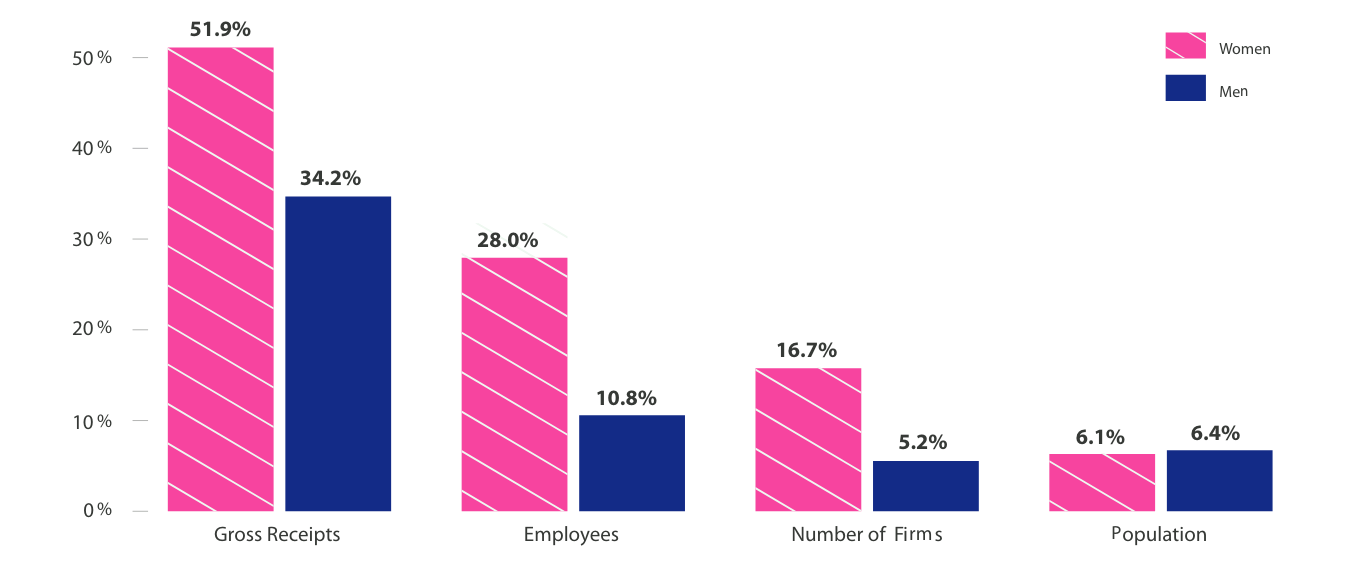
Note: Receipts are in nominal dollars. Population represents the U.S. adult
population.
Sources: U.S. Census Bureau 2012 Survey of Business Owners, U.S. Census Bureau and
National Center for Science and Engineering Statistics, 2020 Annual Business Survey, data
year 2019 American Community Survey1-Year Estimates
Women-owned nonemployer firms totalled 10.9 million in 2018, a share of 41% of all nonemployer businesses in the U.S.
WOMEN-EMPLOYER
FIRMS GREW
16.7%
OF
BETWEEN
2012 AND 2019
TO THE
5.2%
GROWTH RATE FOR
MEN-OWNED FIRMS
Women-Owned Employer Firms vs. Men-Owned Employer Firms Growth Rates

Note: Receipts are in nominal dollars. Population represents the U.S. adult
population.
Sources: U.S. Census Bureau 2012 Survey of Business Owners, U.S. Census Bureau and
National Center for Science and Engineering Statistics, 2020 Annual Business Survey, data
year 2019 American Community Survey1-Year Estimates
Women-owned nonemployer firms totalled 10.9 million in 2018, a share of 41% of all nonemployer businesses in the U.S.
WOMEN-EMPLOYER
FIRMS GREW
16.7%
OF BETWEEN
2012 AND 2019
TO THE
5.2%
GROWTH RATE FOR
MEN-OWNED FIRMS
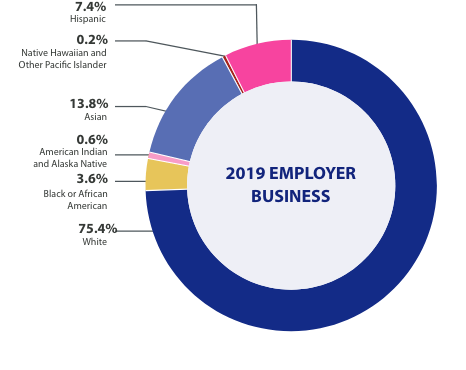
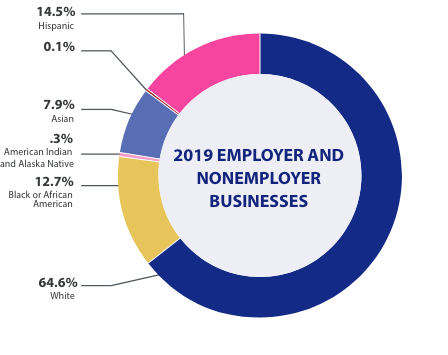
Race and Ethnicity
Among women-owned firms, employer businesses are more likely to be non-Hispanic white- and Asian-Owned, making up 75.4% (911,359) and 13.8% (166,212) of these firms respectively. These shares decline when looking at the combined 2018 employer and nonemployer firms at 64.6% and 7.9%, respectively. On the other hand, Hispanic and Black or African-American women-owned businesses tend to not have paid employees as seen on the right pie chart, boosting the number of employer and nonemployer firms combined to be 1.7 million and 1.5 million or 14.5% and 12.7% versus 7.4% (89,785) and 3.6% (43,696), respectively.
Industry Analysis and the COVID-19 Pandemic
The top ten industries in women-owned businesses are listed on the chart below. It can be observed that the top five sectors of these firms are other services; healthcare and social assistance; professional, scientific, and technical services; retail trade; and administrative and support and waste management and remediation services account for slightly one-third (66.2%) of all women-owned firms. These industry statistics become particularly important when discussing the impact of the pandemic on women’s entrepreneurship. The Department of Labor released a report in April documenting several ways in which women were impacted.
Women were overrepresented in industries that experienced the pandemic’s worst job losses due to industry and occupational segregation.
74.8%
OF HEALTH AND EDUCATION
SERVICE JOBS
78.8%
OF JOBS LOST IN THAT SECTOR DURING THE PANDEMIC 4
Share of Women-Owned Businesses (Top Ten Industries)
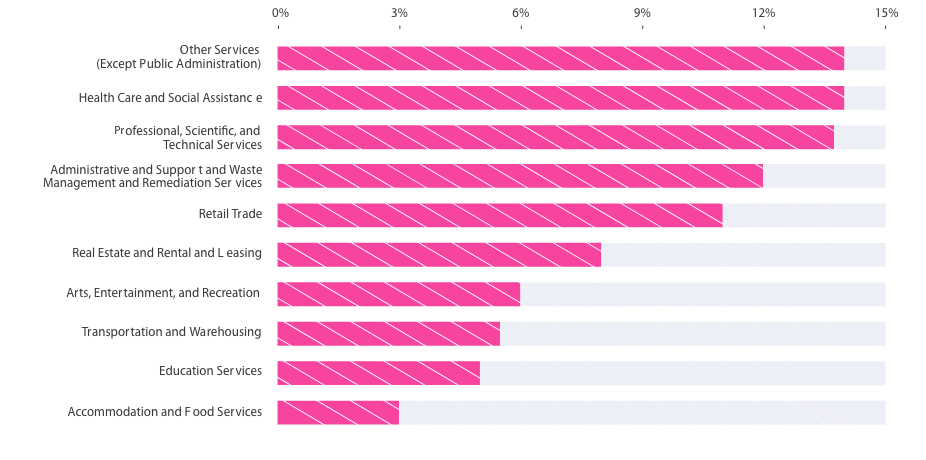
Source: U.S. Census Bureau, 2018 Annual Business Survey and Nonemployer Establishment Statistics-Demographics (NES-D)
Industry Analysis and the COVID-19
The top ten industries in women-owned businesses are listed on the chart below. It can be observed that the top five sectors of these firms other services; healthcare and social assistance; professional, scientific, and technical services; retail trade; and administrative and support and waste management and remediation services account for slightly one-third (66.2%) of all women-owned firms. These industry statistics become particularly important when discussing the impact of the pandemic on women’s entrepreneurship. The Department of Labor released a report in April documenting several ways in which women were impacted.
4 “Bearing the Cost: How Overrepresentation in Undervalued Jobs Hurt Women During the Pandemic.” U.S. Department of Labor (2022), https://www.dol.gov/sites/dolgov/files/WB/media/BearingTheCostReport.pdf.
Share of Women-Owned Businesses (Top Ten Industries)

Source: U.S. Census Bureau, 2018 Annual Business Survey and Nonemployer Establishment Statistics-Demographics (NES-D)
Women were overrepresented in industries that experienced the pandemic’s worst job losses due to industry and occupational segregation.
74.8%
OF HEALTH AND EDUCATION
SERVICE JOBS
78.8%
OF JOBS LOST IN THAT SECTOR
DURING THE PANDEMIC 4
The Imact of the COVID-19 Pandemic on Business Sales
Women-Owned Businesses
Men-Owned Businesses
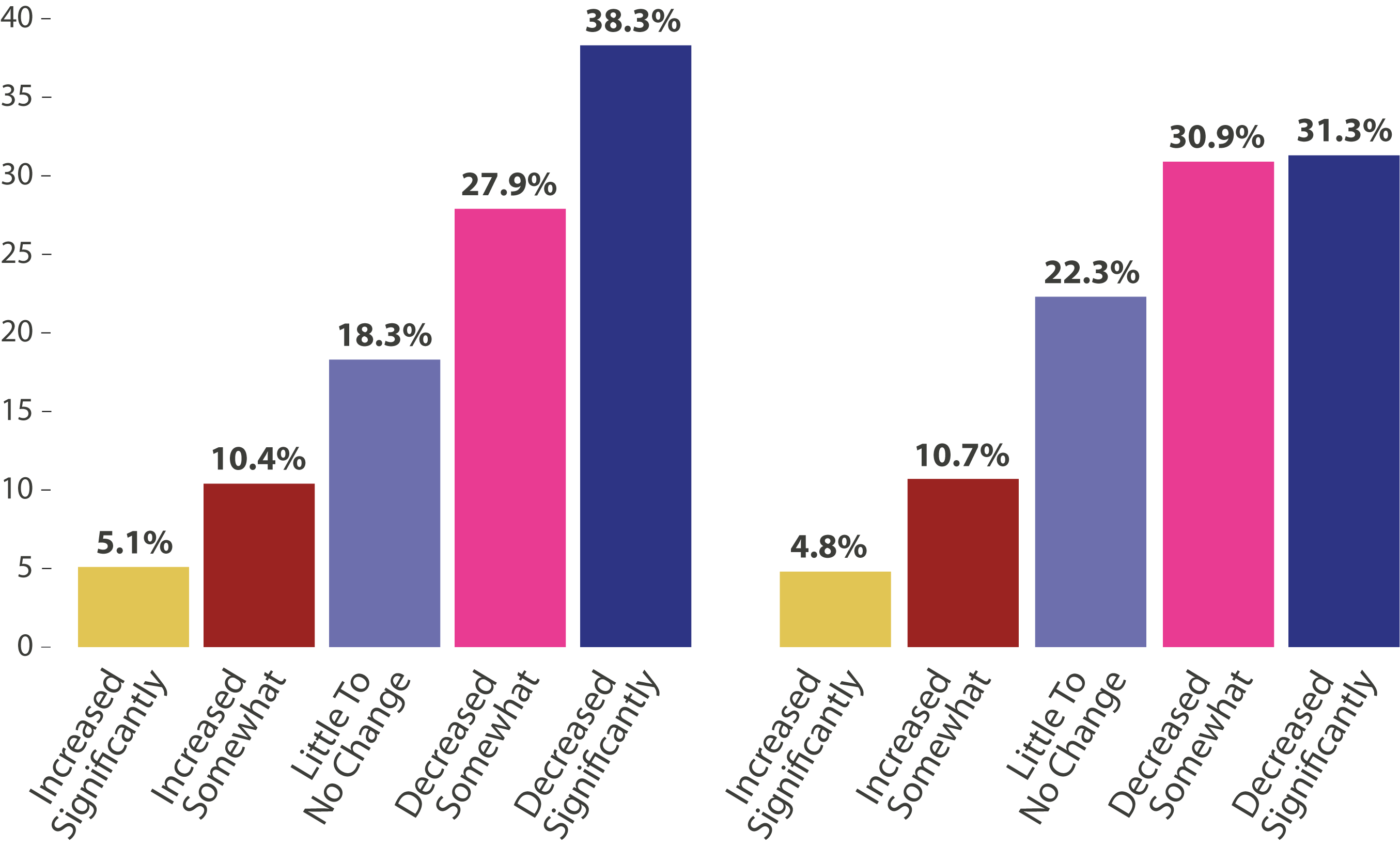
With respect to the pandemic’s impact on businesses, preliminary released statistics from the 2021 Annual Business Survey on the impact of the pandemic also show that 38.3% of women owned businesses said total sales decreased significantly, compared to 31.3% for men-owned businesses. Meanwhile, 18.3% of women-owned firms said there was little to no change in sales vs. 22.3% of men-owned firms.5
Business’s Purpose for Seeking Financingin 2020 (Excluding Forgivable Loans)
Women-Owned Business
Men-Owned Businesses
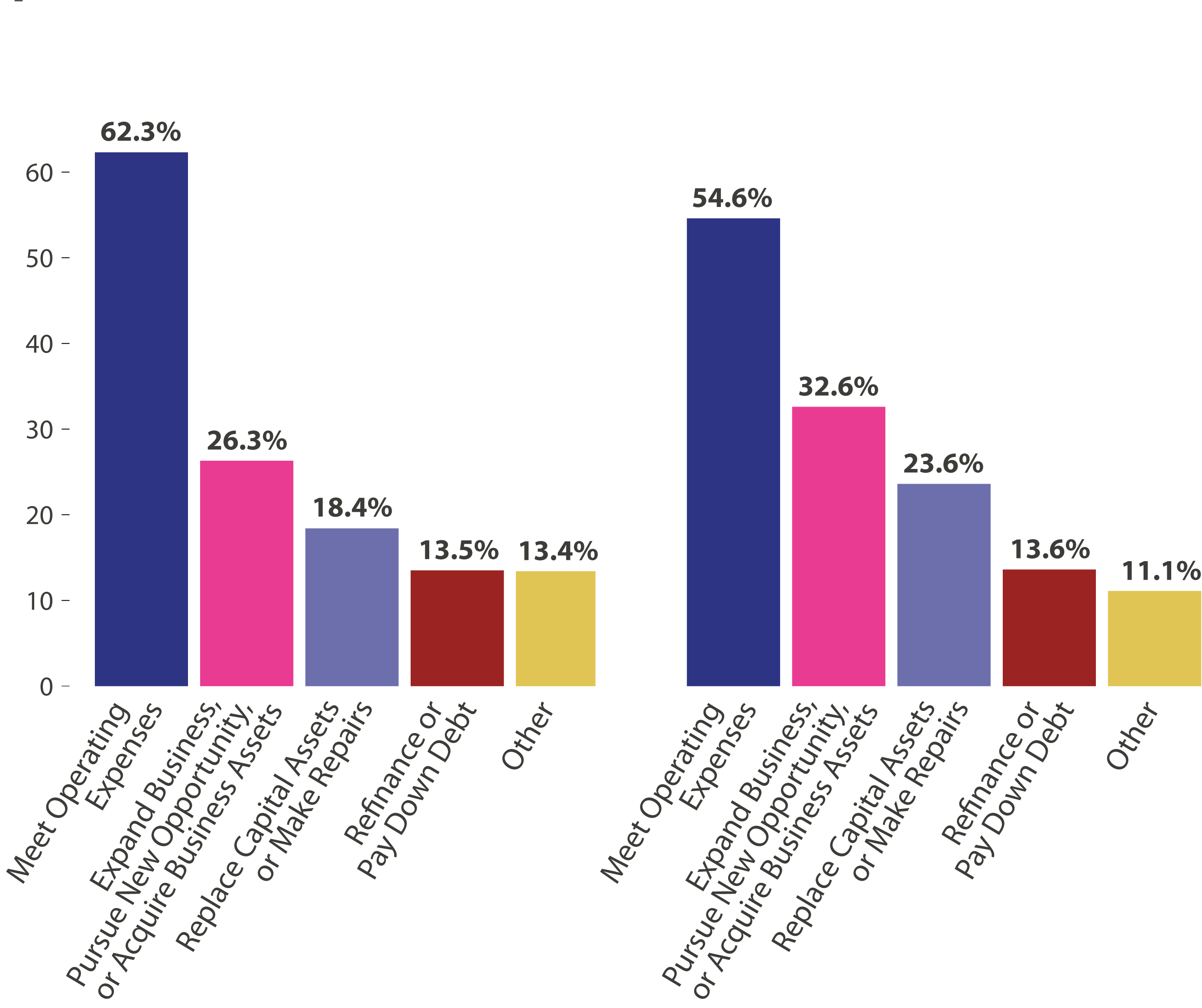
In terms of access to capital, 62.3% of women have sought financing to meet operating expenses vs. 54.6% for men. More men (32.6%) have searched for financing to expand business, pursue new opportunity, or acquire business assets compared to 26.3% of women-owned businesses. These figures are in line with previous research findings on access to capital and women-owned business expansion, which show that women are more reluctant to seek financial capital that could allow them to grow their firms.6
Source: U.S. Census Bureau and National Center for Science and Engineering Statistics,
2021 Annual Business Survey, data year 2020
5 Note: Data are preliminary and will be revised when the final 2021 ABS results are
published. Data shown include only firms classifiable by sex. U.S. Census Bureau and
National Center for Science and Engineering Statistics, 2021 Annual Business Survey, data
year 2020
6 Coleman, Susan. “The role of human and financial capital in the profitability and growth
of women-owned small firms.” Journal of SmallBusiness Management 45.3 (2007): 303-319.
With respect to the pandemic’s impact on businesses, preliminary released statistics from the 2021 Annual Business Survey on the impact of the pandemic also show that 38.3% of women-owned businesses said total sales decreased significantly compared to 31.3% for men-owned businesses. Meanwhile, 18.3% of women-owned firms said there was little to no change in sales vs. 22.3% of men-owned firms.5
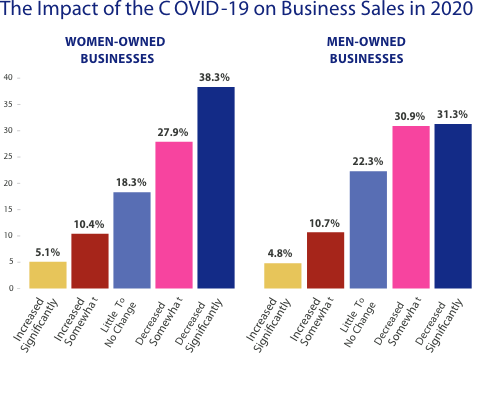
In terms of access to capital, 62.3% of women have sought financing to meet operating expenses vs. 54.6% for men. More men (32.6%) have searched for financing to expand business, pursue new opportunity, or acquire business assets compared to 26.3% of women-owned businesses. These figures are in line with previous research findings on access to capital and women-owned business expansion, which show that women are more reluctant to seek financial capital that could allow them to grow their firms.6
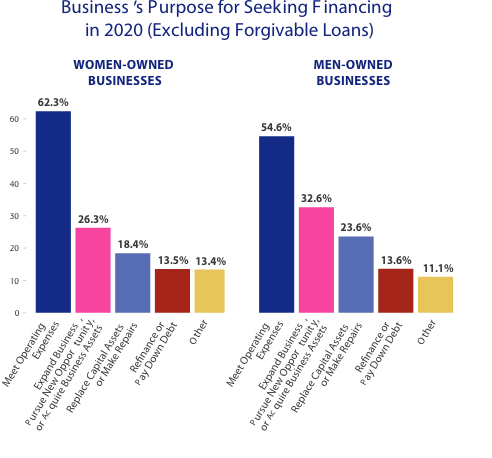
Source: U.S. Census Bureau and National Center for Science and Engineering Statistics,
2021 Annual Business Survey, data year 2020
5 Note: Data are preliminary and will be revised when the final 2021 ABS results are
published. Data shown include only firms classifiable by sex. U.S. Census Bureau and
National Center for Science and Engineering Statistics, 2021 Annual Business Survey, data
year 2020
6 Coleman, Susan. “The role of human and financial capital in the profitability and growth
of women-owned small firms.” Journal of SmallBusiness Management 45.3 (2007): 303-319.
How Women (And Men) Invest in Startups
Innovation Drives the Economy Forward
Women are increasingly leading high-growth firms, which frequently require venture capital to scale. In 2021, the number of deals grew to 13,107 for all male-founder teams, 4,215 for teams with at least one female founder, and 1,072 for all-female founder teams.7 Yet only a small share of venture dollars goes to female founders. Startups with at least one female founder received 17.2% of venture capital for the first half of 2022, according to PitchBook. Startups founded solely by women raised only 2.4% of venture capital.8 Two primary factors account for the gap: women are less likely than men to found scalable startups9, and male investors—who manage most of the dollars invested in startups—are less likely to invest in female-founded startups.10 Closing this gap can have significant impacts. In addition to greater innovation, economic growth, and job creation, profitable exits for female founders—an IPO or acquisition by another company—will help narrow the gender wealth gap.11
Investment Builds Opportunity
Another way to look at this problem is through the lens of investors themselves. Investing in startups asan asset class for high-net-worth individuals (HNWI) is in its nascent stage—only a miniscule percentage of people who can invest do. If investing in startups becomes more accessible to HNWI, particularly women, it has the potential to become a major source of capital for women and Black, Indigenous, and people of color (BIPOC) founders, and the venture funds that invest in them. By leveraging the power of women’s wealth and passion for social responsibility, a more robust, inclusive economy can be created.
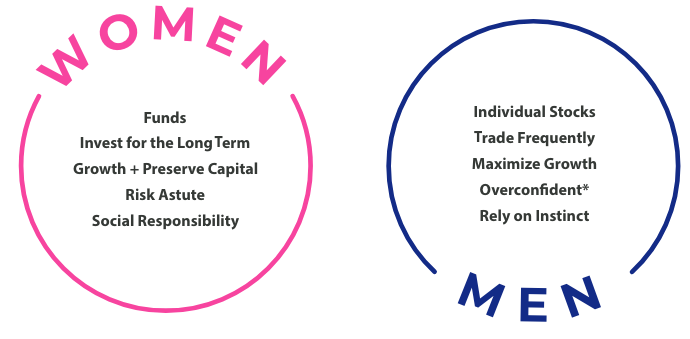
*Barber M. Brad, and Terrance Odean. 2001. “BOYS WILL BE BOYS: GENDER, OVERCONFIDENCE, AND COMMON STOCK INVESTMENT,” Quarterly Journal of Economics, Volume 116, Issue 1, February 2001, Pages 261–292. https://faculty.haas.berkeley.edu/odean/papers/gender/boyswillbeboys.pdf.
7 2022. “The Q2 2022 PitchBook NVCA Venture Monitor,” PitchBook, July 2022.
https://pitchbook.com/news/reports/q2-2022-pitchbook-nvca-venture-monitor.
8 IBID
9 2016. “Kauffman Compilation: Research on Gender and Entrepreneurship, Kauffman
Foundation,” August 2016. https://www.kauffman.org/wp-content/uploads/2019/12/gender_compilation_83016.pdf.
10 Brush, Candida G., Patricia G. Greene, Lakshmi Balachandra, and Amy E. Davis. 2014.
“Diana Report: Women Entrepreneurs 2014: Bridging the Gender Gap in Venture Capital,”
Arthur M. Blank Center for Entrepreneurship Babson College, 2014. https://www.babson.edu/womens-leadership-institute/diana-international-research-institute/research/diana-project/.
11 Chang, Mariko. 2015. “Women and Wealth: Insight for Grantmakers,” Asset Funders
Network, 2015. https://static1.squarespace.com/static5c50b84131d4df5265e7392d/t/5c54781a8165f5b8546f8a34/1549039642955/AFN_Women_and_Wealth_Brief_2015.pdf.
For this goal to become reality, it must be understood that men and women invest differently. For example:
![]() Women offer immense opportunities for wealth management
firms. Women are more likely to rely on their financial advisors’ input than men; men are
more likely to manage their portfolios themselves compared to women.
Women offer immense opportunities for wealth management
firms. Women are more likely to rely on their financial advisors’ input than men; men are
more likely to manage their portfolios themselves compared to women.
Women, Men, and Wealth Management

![]() Wealthy women are sophisticated investors. Women are
much more likely than men to mitigate investment risk by investing in startups to diversify
their portfolios.
Wealthy women are sophisticated investors. Women are
much more likely than men to mitigate investment risk by investing in startups to diversify
their portfolios.
Mitigate Investment Risk by Investing in Startups
![]() Women want to do well by doing good. Women are more
likely than men to invest in startups as a way to make an impact aligned with their values,
to make the world a better place, and to close the gender gap.
Women want to do well by doing good. Women are more
likely than men to invest in startups as a way to make an impact aligned with their values,
to make the world a better place, and to close the gender gap.
Values-Based Investing: Why Do Women and Men Invest in Startups?

These tendencies make women prime prospects to invest in small, emerging, and diverse managed funds. It is also worth noting that the market is growing: Women are poised to inherit a large share of the $30 trillion that will be passed down from Baby Boomers and older generations.12
12 Baghai, Pooneh, Olivia Howard, Lakshmi Prakash, and Jill Zucker. 2020. “Women as the
next wave of growth in US wealth management,” McKinsey & Company, July 29,
2020. https://www.mckinsey.com/industries/financial-services/our-insights/women-as-the-next-wave-of-growth-in-us-wealth-management.
Obstacles to Funding Female VCs and Founders
Female venture fund managers and startup founders have a harder time than their male counterparts raising capital from institutional investors and, as a result, they rely more on HNWI—also known as accredited investors, the term the U.S. Securities and Exchange Commission (SEC) uses. To tap into the accredited investor pool of capital, five obstacles to investment need to be overcome.
High investment requirement by most venture funds excludes most accredited
investors:
The minimum check sizes that most venture funds require are too high to attract most
wealthy women. Nearly three-quarters of both male and female investors would write a
check for $25,000 to invest in startups. For those who said “no, they wouldn’t invest
for $25,000,” 39% of women and 10% of men said they would write a check for $10,000.
Invest in Startups If Check Size Is $25,000 or $10,000

Most women don’t have time to do due diligence: There is a lack of research coverage of startups and small, emerging, and diverse managed funds, making it more important that investors do due diligence or find credible trustworthy sources who have. The time it takes to conduct due diligence on startups and the venture funds that invest in them is time-consuming, and a higher share of women compared to men do not have the time to do it.
No Time to Conduct Due Diligence?

Women had concerns about the time it takes to profit from startup investments: The illiquid nature of the investment means in general money is tied up for five to seven years for direct investments in startups, and ten years for venture funds. Since women take the long view on investing, they are less concerned than men. Still, a substantial minority of women are concerned about locking up their investments for a long period.
Concerned About the Time It Takes to Profit from Startup Investment?

Lack of a track record in VC: The lack of performance data can make raising capital for a first, second, or even third venture fund more difficult. It can take five to seven years before data is available on an emerging manager’s investment thesis—the strategy by which a venture capital fund makes money for the fund investors.13
Investing in startups is risky: A substantial minority of women (41%) indicated investing in startups is risky. Interestingly, they were less likely than men (54%) to indicate investing in startups as risky. Women are risk-aware investors.14
Resistances to Be Overcome in Investing in Startups

Investment Today, Returns Tomorrow
The World Economic Forum has estimated that it will take at least 150 years to close the
economic gender gap.15 Directly investing in women innovators through venture
funds is one promising avenue for bridging this divide. In order to make this progress,
women founders must receive funding, women-led VC firms must raise capital, and women
investors must be empowered to invest. According to Boston Consulting Group, when women get
funding, they generate over twice as much in revenue per dollar invested as their male
counterparts and generate 10% more revenue over five years.16 And when women are
in the position to make decisions, they are twice as likely to invest in startups with at
least one female founder and more than three times as likely to invest in startups with
female CEOs.17 Strategic policy changes today will undoubtedly yield robust
returns for investors and the national and global economy.
13 Bogoslaw, David. 2022. “Women-led VCs hit milestone but still face significant
fundraising challenges,” Venture Capital Journal, May 5, 2022. https://www.venturecapitaljournal.com/women-led-vcs-hit-milestone-but-still-face-significant-fundraising-challenges/.
14
Railey, Meghan. 2022. “If female investors have any weakness, it’s their mistaken belief
that they’re not good investors,” CNBC.com, April 11, 2022. https://www.cnbc.com/2022/04/11/op-ed-heres-why-women-are-better-investors-than-men.html#:~:text=However%2C%20while%20many%20may%20think,2021%20Women%20and%20Investing%20Study.
15
2021. “Gender Parity Accelerators,” World Economic Forum, September 2021. https://www.weforum.org/projects/gender-parity-accelerators.
16
RAbouzahr, Katie, Matt Krentz, John Harthorne, and Frances Brooks Taplett, 2018. “Why
Women-Owned Startups Are a Better Bet,” Boston Consulting Group, June 6, 2018. https://www.bcg.com/publications/2018/why-women-owned-startups-are-better-bet.
17
2019. “All Raise Report on Venture Financing in Female-Founded Startups Shows Progress, Yet
Continued Gender Inequity,” Pitchbook, November 12, 2019. https://pitchbook.com/media/press-releases/pitchbook-all-raise-report-on-venture-financing-in-female-founded-startups-shows-progress-yet-continued-genderinequity.
Investment Today, Returns Tomorrow
The World Economic Forum has
estimated that it will take at least 150 years to close the economic gender gap.15 Directly
investing in women innovators through venture funds is one promising avenue for bridging
this divide. In order to make this progress though, women founders must receive funding,
women-led VC firms must raise capital, and women investors must be empowered to invest.
According to Boston Consulting Group, when women get funding, they generate over twice as
much in revenue per dollar invested as their male counterparts, and generate 10% more
revenue over five years.16 And when women are in the position to make decisions, they are
twice as likely to invest in startups with at least one female founder and more than three
times as likely to invest in startups with female CEOs.17 Strategic policy changes today
will undoubtedly yield robust returns for investors and the national and global economy.
13 Bogoslaw, David. 2022. “Women-led VCs hit milestone but still face significant
fundraising challenges,” Venture Capital Journal, May 5, 2022. https://www.venturecapitaljournal.com/women-led-vcs-hit-milestone-but-still-face-significant-fundraising-challenges/.
14
Railey, Meghan. 2022. “If female investors have any weakness, it’s their mistaken belief
that they’re not good investors,” CNBC.com, April 11, 2022. https://www.cnbc.com/2022/04/11/op-ed-heres-why-women-are-better-investors-than-men.html#:~:text=However%2C%20while%20many%20may%20think,2021%20Women%20and%20Investing%20Study.
15
2021. “Gender Parity Accelerators,” World Economic Forum, September 2021. https://www.weforum.org/projects/gender-parity-accelerators.
16
RAbouzahr, Katie, Matt Krentz, John Harthorne, and Frances Brooks Taplett, 2018. “Why
Women-Owned Startups Are a Better Bet,” Boston Consulting Group, June 6, 2018. https://www.bcg.com/publications/2018/why-women-owned-startups-are-better-bet.
17
2019. “All Raise Report on Venture Financing in Female-Founded Startups Shows Progress, Yet
Continued Gender Inequity,” Pitchbook, November 12, 2019. https://pitchbook.com/media/press-releases/pitchbook-all-raise-report-on-venture-financing-in-female-founded-startups-shows-progress-yet-continued-genderinequity.
Engagement
Highlights
Engagement
Highlights
Engagement
Highlights
October
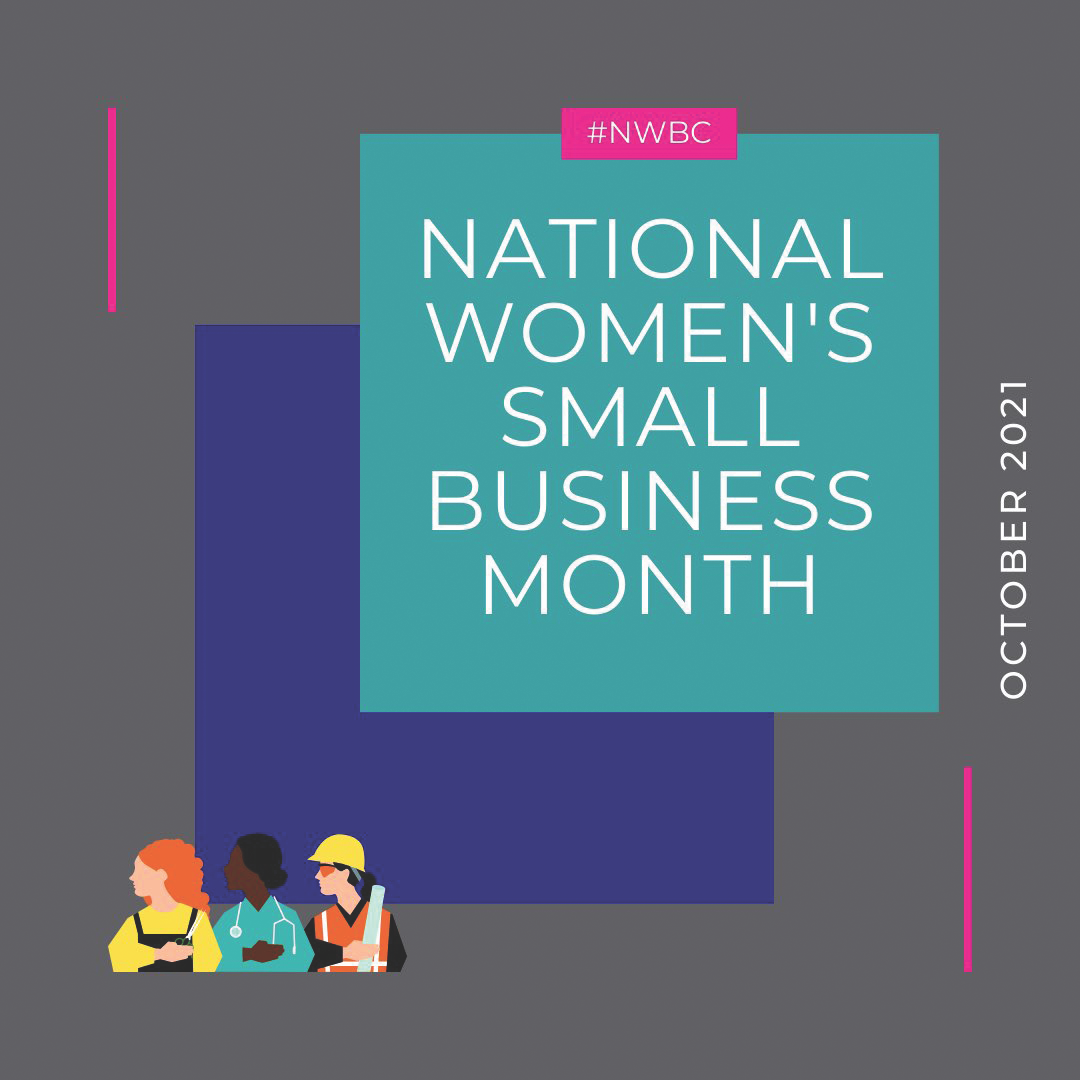
NATIONAL WOMEN’S SMALL BUSINESS MONTH
![]() In celebration of National Women’s Small
Business Month, @NWBC recognized all the small
women-owned businesses that continued to strengthen our communities and drive our
economy.
In celebration of National Women’s Small
Business Month, @NWBC recognized all the small
women-owned businesses that continued to strengthen our communities and drive our
economy.
#womenentrepreneurs #womeninbusinesses
NWBC celebrated and recognized
women-owned
small businesses and the inspiring entrepreneurs who lead them.
October 25, 2021
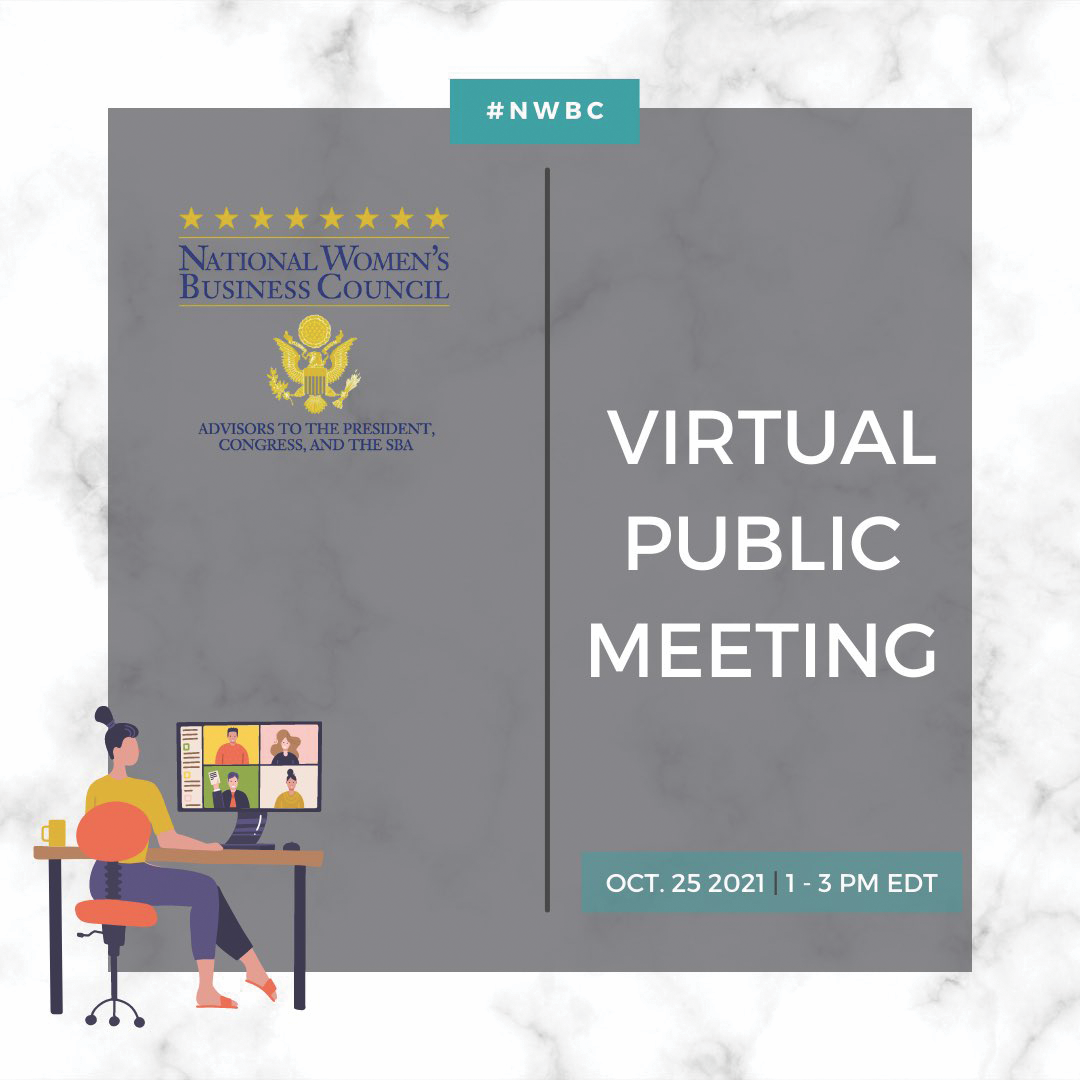
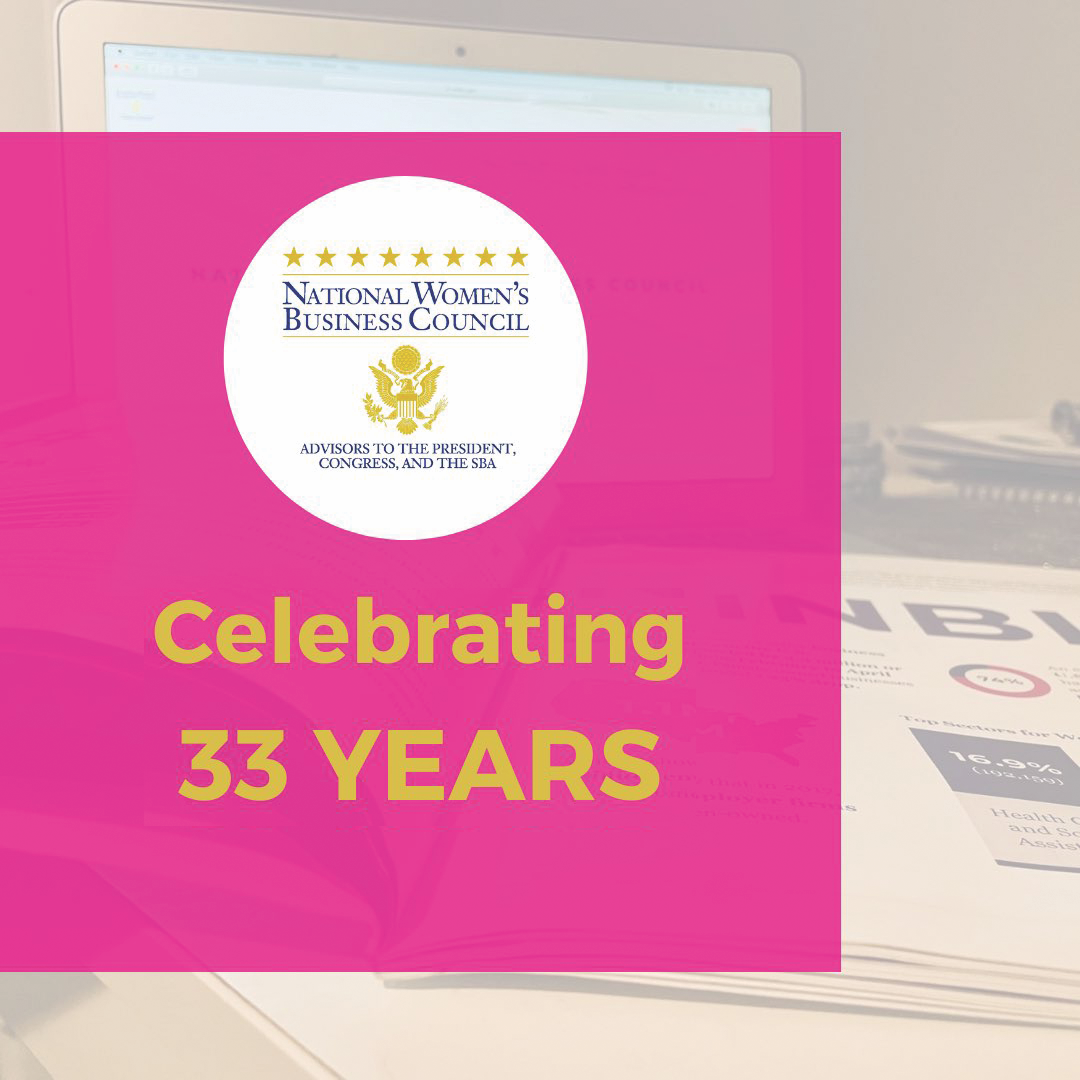
PUBLIC MEETING AND
33-YEAR ANNIVERSARY
The first public meeting of the 2022 fiscal year highlighted achievements from the previous year and provided updates on NWBC initiatives and policy development. Each of the Council’s subcommittees—Rural Women’s Entrepreneurship, Women in STEM, and Access to Capital & Opportunity—presented their priorities and projects before the full body and the public.
NWBC celebrated 33 years in service on October 25! Since the passage of H.R. 5050: Women’s Business Ownership Act of 1988, the Council has worked diligently to represent the interests of women business owners through recommendations to the White House, Congress, and the SBA Administrator.
February 4, 2022
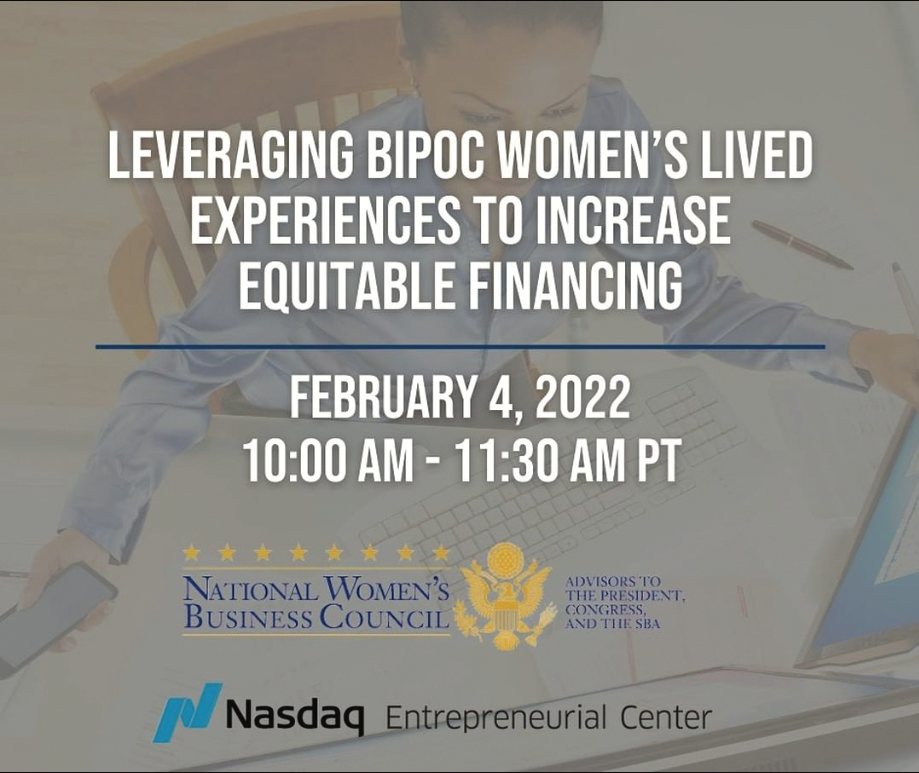
Roundtable on Leveraging BIPOC Women’s Lived Experiences to Increase Equitable Financing
NWBC’s Council Members held a roundtable in collaboration with the Nasdaq Entrepreneurial Center on equitable financing. On February 4, 2022, they convened entrepreneurs, resource partners, and other key stakeholders to discuss the issues BIPOC women entrepreneurs and founders continue to face when attempting to access equitable financing opportunities to fund a new or growing business.
March 16, 2022
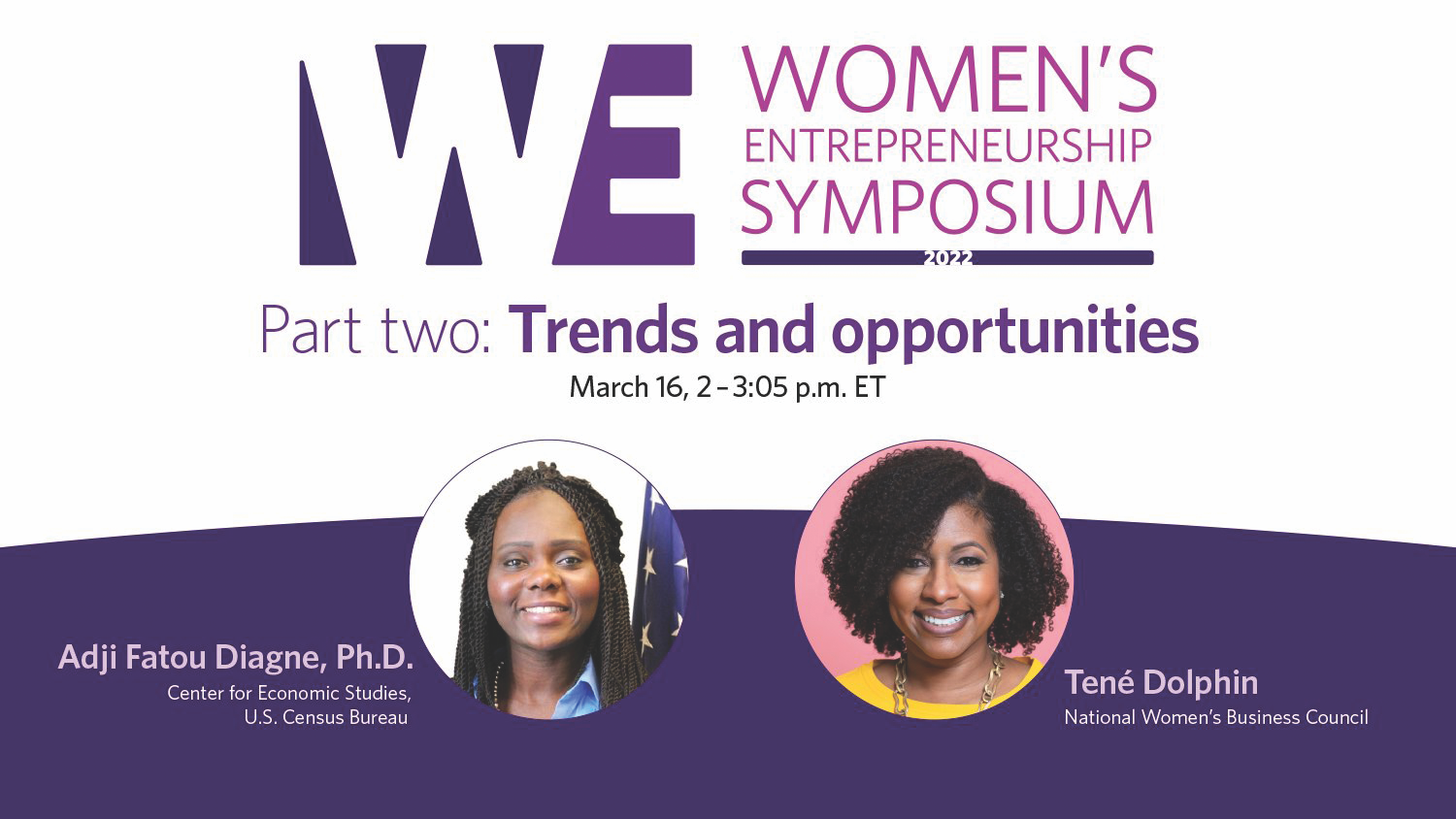
USPTO WOMEN’S ENTREPRENEURSHIP SYMPOSIUM
NWBC Executive Director Tené Dolphin lent her voice to a conversation hosted by the U.S. Patent and Trademark Office (USPTO) on trends and opportunities during the office’s Women’s Entrepreneurship Symposium.
March 28-30, 2022
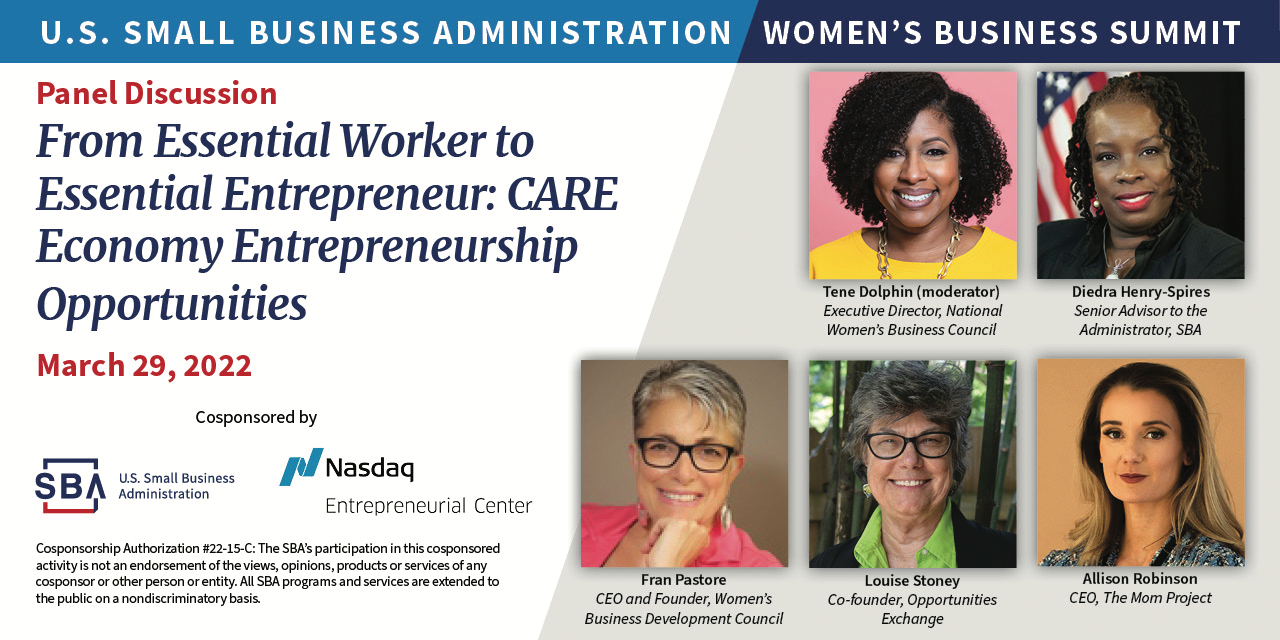
SBA WOMEN’S BUSINESS SUMMIT
SBA capped off Women’s History Month by holding the inaugural Women’s Business Summit from March 28 to 30. Familiar faces from NWBC, including Council Members Jaime Gloshay and Maria Rios. as well as Executive Director Tené Dolphin, played a key role across numerous panels.
May 3, 2022
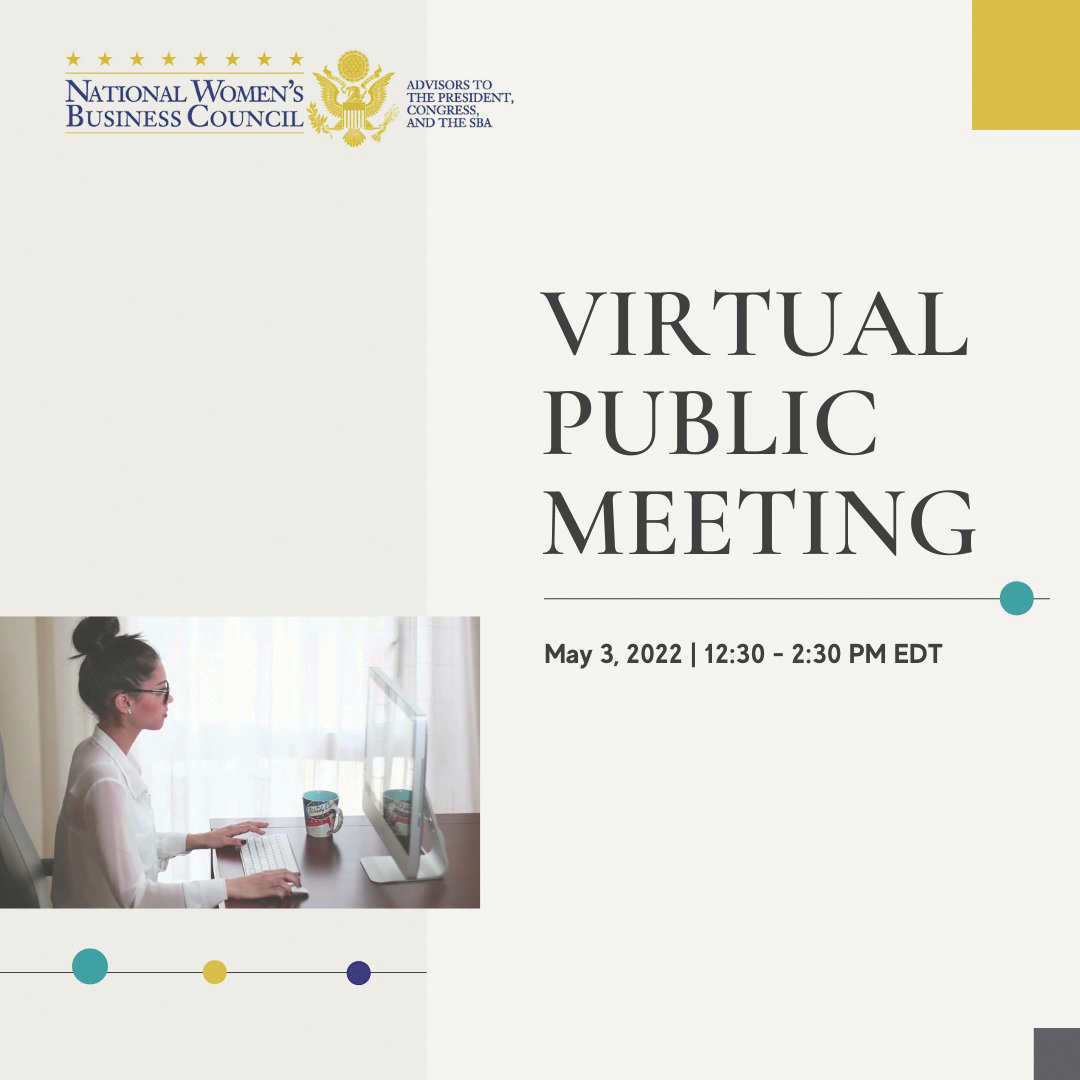
Public Meeting
On May 3, NWBC held its second public meeting of the fiscal year. The meeting gave Council Members and the public the opportunity to hear directly from experts and women’s business organizations about issues that matter most to women entrepreneurs. It also gave NWBC the chance to welcome three new Council Members: Roberta McCullough, Jaime Gloshay, and Dr. Shakenna Williams.
May 9, 2022
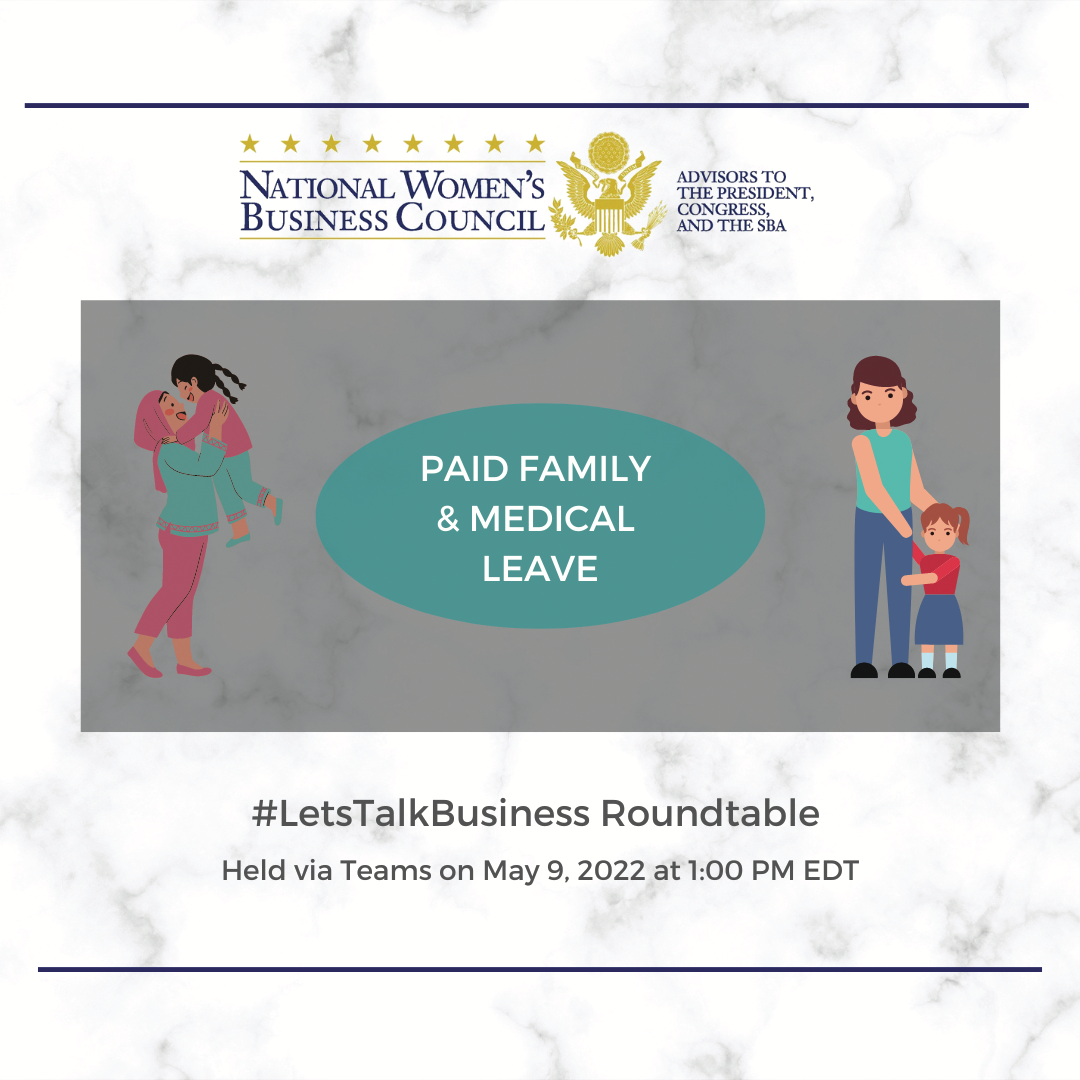
NWBC PAID FAMILY AND MEDICAL LEAVE (PFML) ROUNDTABLE
On May 9, 2022, NWBC convened women business owners, subject matter experts, government officials, and other key stakeholders to delve into paid family and medical leave (PFML). This discussion focused on how the lack of equitable access to PFML may create barriers to women’s entrepreneurship.
June 28, 2022
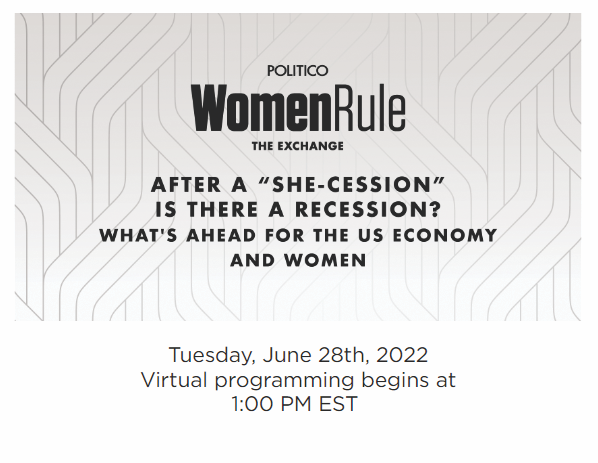
Women Rule Panel
Executive Director Tené Dolphin participated on a panel hosted by Politico on June 28, 2022. The event was focused on how women business owners can be prepared for the ever-changing economic landscape based on current events and changes.
July 2, 2022

E-SUITE PANEL AT ESSENCE FEST
Council Member Selena Rodgers Dickerson was invited to be on the Essence Fest 2022 E-Suite Women’s Empowerment Session panel. The six panelists focused on how Black women-owned businesses can expand their reach and access in entrepreneurship.
August 1, 2022
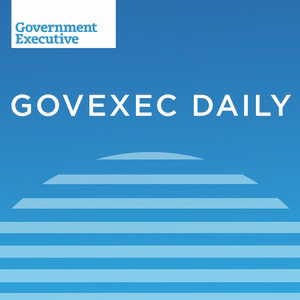
GOVEXEC DAILY PODCAST
Council Member Pamela Prince-Eason appeared on the GovExec Daily podcast to discuss how the pandemic and current economic climate have impacted women. She deftly leveraged her experiences on the Council and as chief executive officer/president of the Women’s Business Enterprise National Council to paint a picture of the current state-of-play facing women entrepreneurs and what may lie ahead.
September 14, 2022
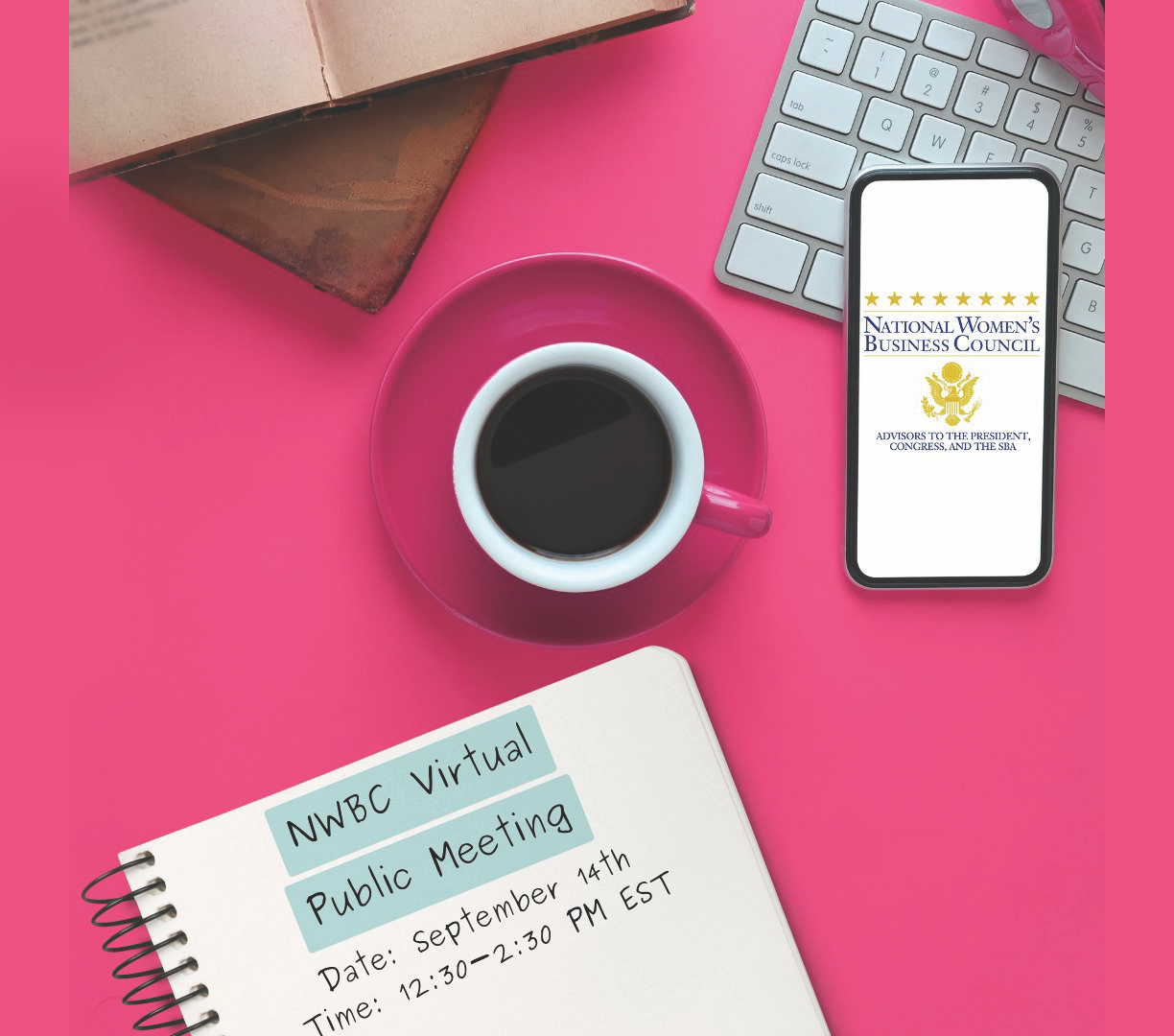
NWBC PUBLIC MEETING
On September 14, 2022, the National Women’s Business Council held a virtual public meeting via Zoom from 12:30 to 2:30 p.m. eastern daylight time. The meeting gave Council Members the opportunity to recap engagements from the past year and deliberate policy recommendations before a public audience.
Quick Reference
ANNUAL POLICY RECOMMENDATIONS
Quick Reference
Quick Reference
ANNUAL POLICY
RECOMMENDATIONS
Quick Reference
Quick Reference
ANNUAL POLICY
RECOMMENDATIONS
ACCCESS TO CAPITAL & OPPORTUNITY
Showcase the Policy “Wins” for Women in Business and Work Toward Systemic Change
But First, Just Fund Her: Create a Financing Bridge to a “Capital Stack” and Promote WOSB Growth
Define “Microbusiness” and Reconsider Debt Relief Options for Micro- and Small Women-Owned Enterprises Impacted by Global Disruptions
Advance and Grow a Community of Women Investing in Women-Owned Businesses
Continue to Strengthen and Work Toward Parity for the WOSB/EDWOSB Federal Contracting Program
Fund, Expand, and Tailor Federal Financial Capability Resources for Women Small Business Owners
Provide Additional Relief for WOSBs Impacted by Ongoing Supply Chain Disruptions and Workforce Availability Issues
WOMEN IN STEM
Women In Academic Innovation
High Yield and High Growth Fields with Low Levels of Women-Owned Business Representation
The STEM Pipeline
RURAL WOMEN’S ENTREPRENEURSHIP
Persistent Barriers to Rural Women’s Entrepreneurship: Lack of Affordable Child Care and Equitable Paid Family and Medical Leave (PFML)
Gain Fresh Insights on Rural Ecosystems: Workforce Development Issues, Local Governance, and Capacity Issues Impacting Rural and Tribal Women Entrepreneurs
Empower Rural Women Entrepreneurs to Thrive in Tomorrow's Global Economy, Today
Enhance Federal Support and Coordinated, Accessible Resources for Rural Women Entrepreneurs
Down to The Roots: Leverage Community-Based Supports to Bolster Rural Women Entrepreneurs

Policy
Recommendations
Policy
Recommendations
Policy
Recommendations
Policy Recommendation
ACCESS TO CAPITAL AND OPPORTUNITY
Showcase the Policy “Wins” for Women in Business and Work Toward Systemic Change
Women are an economic force influencing U.S. and global markets.
$10 TRILLION
OF TOTAL U.S. HOUSEHOLD FINANCIAL ASSETS1
80%
OR MORE OF CONSUMER SPENDING2
$10 TRILLION
OF TOTAL U.S. HOUSEHOLD FINANCIAL ASSETS1
80%
OR MORE OF CONSUMER SPENDING2
Moreover, women business owners in the U.S. constitute about 41percent (10.9 million) of businesses without paid employees and 19.9 percent (1.1 million) of employer-based businesses, employing an estimated 10.1 million workers. These women-owned employer-based businesses also reportedly accumulated $1.8 trillion in receipts in 2019, just prior to the onset of the global pandemic. Despite their commanding presence in the marketplace and their tremendous economic value, persistent challenges to women’s entrepreneurship, predating COVID-19, remain. Whether attempting to access capital, tailored entrepreneurial development resources, meaningful and legitimate mentorship experiences, or federal contracting opportunities, women business owners continue to share with this Council their own lived experiences and the urgent need for impactful policy change, as well as increased information and heightened awareness of the policy wins helping advance women’s business enterprise.
Tackling these historical inequities is now a topic that is front and center of a national conversation. Notably, the White House Gender Policy Council (GPC) established in March 2021 also recently developed “the first-ever National Strategy on Gender Equity and Equality [which seeks to] advance equal rights and opportunity” for more women. The Council remains encouraged by the establishment and work of the GPC. NWBC agrees that prioritizing women, minority, and other economically disadvantaged entrepreneurs’ access to federal programs and financing constitutes a critical first step to eradicating gender and racial disparities with respect to providing entrepreneurial supports and fair access to financing and business opportunities. The White House, and particularly the GPC, is uniquely positioned to help elevate recent “policy wins” and newly enhanced resources for women in business.
Policy Recommendation
But First, Just Fund Her: Create a Financing Bridge to a “Capital Stack” and Promote WOSB Growth
On February 4, 2022, the NWBC held an “Access to Capital & Opportunity” policy roundtable together with the Nasdaq Entrepreneurial Center (NEC). This policy roundtable convened women business owners, government officials, resource partners, and other key stakeholders to address the ongoing challenges BIPOC (Black, Indigenous, People of Color) women entrepreneurs face when attempting to access fair financing opportunities to fund a startup or scale a growing business. 5Roundtable participants also underscored the need for systemic change rather than focusing on overtraining or in some way fixing women entrepreneurs.
Roundtable participants also underscored the need for systemic change rather than focusing on overtraining or in some way fixing women entrepreneurs. These findings align with much of the research and recent available data on this topic. For instance, while women entrepreneurs generally present a lower risk6 and deliver higher returns7, they often face more discouragement from applying for loans8. In fact, recent data indicate that women typically receive lower loan amounts than men for a variety of reasons but are “charged slightly higher interest rates.”9 Noting this important feedback, any future or prospective SBA lending program should not include any future training prerequisites to financing or loan eligibility.
With respect to investments, as highlighted in the roundtable key takeaways above, “women of color founders account for only [about] 0.6 percent of all VC funding.”10 Given the current landscape, particularly for women entrepreneurs of color, exploring alternative lending criteria which takes into consideration these business owners’ lived experiences and their potential for success is critically important. Thus, reconsideration of lending criteria and even more affordable financing and flexible repayment options would better support and fuel the growth of both rising and scaling women-owned businesses.
Policy Recommendation
Define “Microbusiness” and Reconsider Debt Relief Options for Micro- and Small Women-Owned Enterprises Impacted by Global Disruptions
During NWBC’s May 2022 public meeting, several national women’s business organizations shared information about their programmatic and policy priorities. For example, Karen Bennetts, Chair-Elect for the National Association of Women Business Owners (NAWBO) shared that “addressing the needs of ‘microbusinesses’” is critical and discussed the need to define and codify the term “microbusiness” for use by all federal agencies. She explained that differentiating “microbusiness” from “small business” is critical to helping more women entrepreneurs access capital and procurement opportunities. During subsequent NWBC “Access to Capital and Opportunity” subcommittee meetings, Council Members agreed this was an important distinction to raise before the full Council.
Subcommittee discussions also centered on other key factors that have impacted women business owners’ ability to successfully access pandemic relief funding, as well as financing for growth in the years leading up to and following the onset of COVID-19. Both Council Members Selena Rodgers Dickerson and Pamela Prince-Eason discussed the negative ramifications of unfair practices on women’s entrepreneurship in the processing of payments as well as predatory lending practices. Council Member Jaime Gloshay also doubled down on the problem of predatory lending and noted the importance of challenging some underwriting requirements, as well as considering “relationship lending” program models. She also noted that it is important to address both gender and racial discrimination and shared that in Native communities, predatory lending is a big problem and most Native Women business owners tend to self-fund.12
Notably, a recent study co-authored by a Cleveland Fed researcher found that “compared to small businesses owned by men, those owned by women faced more operational and financial challenges and were less likely to receive financing.”13 And, “those owned by Black women, faced more financial and operational challenges during the pandemic and were less likely to receive financing.”14 Women’s lack of access to pandemic relief certainly came to the national forefront during the first tranche of the Paycheck Protection Program (PPP).15 By some accounts, “the discrepancy of average loan amounts between male and female owners [was] even higher than the data suggests for the first time period PPP loans were given.” Moreover, longstanding inequities such as the high cost of capital for many women and minorities has significantly impaired their ability to grow and scale, and thus served as yet another barrier to buildinggenerational wealth via a successful business and strategic exit.17
However, Council Members also remained focused on how to better support women entrepreneurs who successfully accessed relief or other forms of financing prior to, or during the pandemic, and may still be struggling. Remarkably, according to 2021 Goldman Sachs data, about 40 percent of small business owners expressed worry that “the debt they … accumulated during the Covid-19 pandemic … [would] hinder their ability to recover. Even more Black owners (55 percent) [expressed] this concern.18 This data also indicates that just last year, “[n]early 60 percent of Black women small business owners and almost half of women owners overall continue[d] to struggle financially due to the pandemic.”19
Initial steps to help alleviate these financial worries could include defining “microbusinesses” to distinguish these enterprises from small businesses, gleaning learnings from the PPP debt relief model to better inform and potentially expand debt relief options across other SBA lending programs, and continuing to prioritize the needs of women business owners, including those operating in industries with unique workforce retention and scale-up challenges, such as in the care economy.
Congress should develop and provide a uniform definition for a microbusiness. Additionally, Congress and SBA should consider further expansion of debt relief options for certain 7(a), 504, and microloan borrowers, and continue prioritizing the needs of economically disadvantaged micro-and small business borrowers in industries with significant participation by women, particularly those severely impacted by pandemic-related global supply chain issues or other major global economic disruptions.
Policy Recommendation
Advance and Grow a Community of Women Investing in Women-Owned Businesses
During NWBC’s second “Access to Capital and Opportunity” subcommittee meeting, Council Members heard from Julie Castro Abrams, CEO and Chair of How Women Lead and Founder of How Women Invest. She presented on the current state of women-led venture capital (VC) firms and the need to update the current venture ecosystem to better support minority- and women-led VC firms, given that these tend to make more investments in women-owned startup businesses. Notably, some of these women-owned startups are doing the important work of bringing to market products and services for unmet demands (e.g., health tech and “fem tech”).20
As featured in this annual report’s “By the Numbers” data section, women are increasingly
leading promising high-growth firms, which require significant investmes to scale. And while
there has been a slight investment uptick in women-owned firms in recent years, only a small
share of venture dollars goes to female founders today.21 In fact, according to
Pitchbook, “startups with at least one female founder received 17.2% of venture capital for
the first half of 2022 … [while] startups founded solely by women raised only 2.4% of
venture capital.”22 Two main explanations given for such low level investments in
women-owned businesses are:
1) women are less likely than men to found scalable startups23 and 2) male
investors are less likely to invest in female-founded startups.24
However, recent research findings suggest that supporting VC firms which closely align ntwith high-net-worth women and their priorities, taking into consideration how they invest, would likely incentivize new investments in women-owned firms. “Women want to do well by doing good. Women are more likely than men (51% vs 39%) to invest in startups as a way to make an impact aligned with their values, to make the world a better place (45% vs 23%) and to close the gender gap (56% vs 41%).”25 As such, increased support for women-led VC firms would likely help to draw new female investors, narrow the gender wealth gap,26 help bring about positive social impact, and further catalyze innovation and a national post-pandemic economic recovery.
Council Members expressed their intention to further study the issue and viable policy solutions during the next fiscal year. In the interim, NWBC believes Congressional hearings on this topic would be beneficial, as well as establishing grants to help boost recently established VC firms, particularly those with under $50 million and with less than three years of operation, many of which are led by women and minorities.
Also notable, separate and apart from the topic of how to best support women-led VC firms,
at the time of the writing of this report SBA Administrator Isabella Casillas Guzman
“announced the Federal Register publication of SBA-proposed reforms to the Small
Business Investment Company (“SBIC”) program designed to reduce financial barriers and
increase access and diversity in the U.S. small business investment
ecosystem … The proposed rule, SBIC Investment Diversification and Growth, seeks to address
structural aspects of the SBIC program which have historically limited the flow of SBIC
regulatory capital to small businesses and startups not adequately served by private
investors alone.”
For example, one of the proposed reforms is to:
Policy Recommendation
Continue to Strengthen and Work Toward Parity for the WOSB/EDWOSB Federal Contracting Program
Since the 1950s, “Congress has used its broad authority to impose requirements on the federal procurement process to help small businesses receive a fair proportion of federal contracts and subcontracts, primarily through the establishment of federal procurement goals and various contracting preferences.”28These preferences include restricted competitions known as set asides and sole source awards.29
The SBA’s WOSB Federal Contracting Program is just one of those programs. The federal government’s goal is to award at least five percent of all federal contracting dollars to women-owned small businesses each year.30 This is to be accomplished via set asides and sole source awards, but this goal has only been met twice since it was first authorized in 1994 and implemented in 2011. However, as explained in a July 2022 Congressional Research Service report titled SBA Women-Owned Small Business Federal Contracting Program, “[m]ost of the federal contracts awarded to WOSBs are awarded in full and open competition with other firms or with another small business preference, such as an 8(a) or HUBZone program preference. Relatively few federal contracts are awarded through the WOSB program.” 31
Council Members serving on this “Access to Capital and Opportunity” policy subcommittee agree and have repeatedly expressed concern that in addition to federal agencies not having sufficient experience utilizing the WOSB program, the program:
Notably, the SBA updated its list of eligible industries for the program earlier this year. The March 2022 list of industries determines which WOSBs may receive set-aside (limited competition) and sole-source (noncompetitive) contracts from federal agencies.33 At the time of the writing of this report, the “SBA … considers WOSBs to be ‘substantially underrepresented’ in 646 six-digit NAICS [North American Industry Classification System] industry codes out of 1,023 total six-digit codes, and ‘underrepresented’ in 113 six-digit NAICS industry codes.”34
Recognizing that the federal government is the largest buyer of goods and services in the country35, and the potential for growth it offers for women-owned small business owners, Council Members have identified four key policy proposals to help achieve parity of the WOSB/EDWOSB federal contracting program and ensure more women business owners get their fair share of federal contract awards.
Council Members have identified four key policy proposals to help achieve parity of the WOSB/EDWOSB federal contracting program and ensure more women business owners get their fair share of federal contract awards.
Policy Recommendation
Fund, Expand, and Tailor Federal Financial Capability Resources for Women Small Business Owners
Although women entrepreneurs, particularly women of color, have expressed some concern and even frustration over receiving redundant training in lieu of access to capital opportunities36, Council Members agree that providing financial education tailored to suit women small business owners’ needs at every stage of the business cycle remains critical to ensuring business sustainability and success. Council Member subcommittee discussions on this topic centered around expanding existing resources or creating new customized programs which emphasize knowledge and skill-building for managing cashflow, engaging in financial document organization and emergency preparedness, building a “good” credit score, creating a capital stack, reinvesting in the business, and planning for business succession or a successful exit.
Council Member Roberta McCullough, for example, has noted the importance of helping women entrepreneurs better understand the impact that the U.S. credit scoring system can have on their business, while simultaneously urging for a careful assessment of proposals that look to reform or altogether overhaul the U.S. credit reporting system— a system which some argue is flawed, lacks transparency, and is likely the source of various and very troubling racial disparities.37 Additionally, Council Member Jaime Gloshay has expressed agreement on this point, and has also noted that because many women of color, such as Native women, may be self-funded and without access to relationship banking or investor networks, enhanced education together with well-sourced wraparound community-based supports could prove impactful.
While there are a whole host of federal financial education programs currently in existence, there is no dedicated source of funding to support tailored financial capability specifically for women small business owners at the ground level. Council Member Maria Rios has opined that dedicated funding to establish financial education grants to help bolster resource partners’ important work in this regard would be beneficial. Council Member Pamela Prince-Eason has also expressed agreement on this point and added that helping women business owners better understand and manage cash flow, create a strategic business plan, or properly prepare to hire that first employee are all fundamentally important,38 to a well-tailored program.
On background, SBA’s Ascent program currently includes a “fifth journey”— access to capital — to better prepare women business owners as they consider financing their dream. The journey covers five separate “excursions,” including: debt funding, equity resources, capital sources, banking relationships, funding pitches, and angel investing.39 Additionally, as highlighted in past NWBC annual reports, SBA remains an active participant of the twelve-member Financial Literacy and Education Commission (FLEC).40 SBA has also partnered in recent years with the Federal Deposit Insurance Corporation (FDIC) to develop and later update the Money Smart for Small Business41 program and curriculum available in English and Spanish. Council Members are encouraged by SBA’s ongoing efforts, which may be taken one step further by leveraging dedicated financial education grants for certain small business resources partners engaged in this work.
Policy Recommendation
Moreover, this legislation is positioning more small businesses to grow and create new jobs by “doubling the research and development (R&D) tax credit for small businesses” from $250,000 to $500,000.
Provide Additional Relief for WOSBs Impacted by Ongoing Supply Chain Disruptions and Workforce Availability Issues
Small business owners, including women business owners, continue to deal with ongoing supply chain disruptions and labor shortages, stemming in part from a post-COVID economic recovery, global inflation, and geopolitical conflicts abroad.42 While women business owners remain resilient and optimistic, the Council contends that additional relief is needed moving forward.
On background, the Employee Retention Credit (ERC) provided for in the Coronavirus Aid, Relief, and Economic Security (CARES) Act is a payroll tax refund available to certain employer-based firms that experienced a significant decline in gross receipts in 2020 or during the first three quarters of 2021 or experienced a “full or partial suspension of operations due to a government order if … the business’ suppliers [were] unable to make deliveries of critical goods or materials due to a governmental order that cause[d] the supplier to suspend its operations.”43 However, supply chain disruptions persist. Small business owners, particularly WOSBs, require and could benefit from an expansion of this type of tax relief for additional losses sustained beyond 2021.
Beyond tax relief measures, however, it is also worth mentioning that in 2021, the Biden-Harris Administration established a “Supply Chain Disruptions Task Force” to address short-term supply chain discontinuities.The White House also released an assessment of four products identified as critical at the time including: “semiconductor manufacturing and advanced packaging; large capacity batteries; … critical minerals and materials; and pharmaceuticals and active pharmaceutical ingredients (APIs)”44 to support investments in the President’s American Jobs Plan.
Additionally, the “Inflation Reduction Act [IRA], which includes expanded or extended tax credits and additional funding for the IRS, was signed into law on August 16, 2022.”45 According to the White House, “the Inflation Reduction Act will reduce costs for small businesses by maintaining lower health care costs, supporting energy-saving investments, and bolstering supply chain resiliency.”46 For instance, the legislation signed into law in August 2022 helps cut energy costs for small businesses. Small businesses that switch over to low-cost solar power may be eligible for a tax credit; small business building owners may also “receive a tax credit up to $5 per square foot to support energy efficiency improvements,” and those that “use large vehicles like trucks and vans will benefit from tax credits covering 30 percent of purchase costs for clean commercial vehicles.”47
Moreover, this legislation is positioning more small businesses to grow and create new jobs by “doubling the research and development (R&D) tax credit for small businesses” from $250,000 to $500,000. And, among other provisions, IRA “includes targeted tax incentives aimed at manufacturing U.S.-sourced materials like batteries, solar, and wind parts, and technologies like carbon capture systems and electrolyzers to make hydrogen.”48 Moreover, it is described as a critical step toward making the U.S. tax code fairer by ensuring that the larger corporations “pay taxes they already owe … and cracking down on … corporations with more than $1 billion in annual profits,” as well as “imposing a 1 percent surcharge on corporate stock buybacks.”49
While all these and similar efforts and accomplishments are laudable, this Council also urges the White House and Congress to identify new opportunities to expand tax relief for small business owners as well as consider easing eligibility requirements,50 particularly for care economy businesses and those in industries with a significant women and minority business owner presence, and that experience a significant interruption in their operations and loss of revenue due to ongoing supply chain disruptions and/or labor shortages. Given the possible challenges that may still lie ahead, expanding tax relief such as the ERC and simplifying qualifying criteria as well as records submission requirements would potentially provide much needed relief for these struggling businesses.
Policy Recommendation
Women in Stem
Women in Academic Innovation
Women’s lack of inclusion in today’s innovation ecosystem and STEM entrepreneurship remains concerning to Council Members. While the gender gap within STEM disciplines continues to slowly narrow, gender parity in innovation will not happen within our lifetimes by most estimates.51, 52 Nonetheless, women represent an important source of untapped potential for spurring American innovation and entrepreneurship. Women are becoming more involved in academic settings than ever. About half of U.S. doctorates are earned by women. Additionally, academic institutions are now the largest employer of women with doctorates in science, engineering, and health (SEH).53, 54 However, while the presence of women in academia grows and universities expend billions of dollars in research, secure thousands of patents, and incubate and accelerate hundreds of startups each year,55 only a small percentage of women end up participating as a sole female founder or co-founder.56
Notably, only 11 percent of approximately 6,000 academicbased companies surveyed by Osage University Partners, analyzed in 2017, had a female scientific founder or co-founder.
The current landscape reflects a lack of intentional inclusion of women in innovation and business opportunities and a lack of supports for professionals with caretaking responsibilities, further weakened by COVID-19. Specifically, with respect to women’s journeys in STEM careers, the gap in leadership and innovation curiously begins to widen as women progress in their profession. This is often referred to as a “leaky pipeline” for those in highly specialized fields, including business and management consulting.57 A 2022 Stanford Social Review article suggests that women divert from STEM not because of their individual life choices, but rather, “because opportunities begin to diminish [due to] systemic barriers and layers of biases.” 58 Worst of all, the lack of inclusion of women in innovation negatively impacts the effectiveness, or even the availability, of a much-needed product. The article goes on to say, “the impact of these barriers and biases extends beyond workplaces; they shape STEM products and innovations themselves. Multiple studies have shown that gender and racial bias in product design can have significant, even deadly, effects.”59
Given these considerations, Council Members serving on the “Women In STEM” policy subcommittee expressed interest in exploring best practices for leveraging academic innovation to strongly position women to engage in all stages of the innovation lifecycle, including in patenting, commercialization, and STEM business ownership. This year, Council Members heard from subject matter expert Jane Muir, who founded her own consulting firm following a 25-year career in technology commercialization at the University of Florida’s (UF) “Innovation Hub,” helping pair entrepreneurs with development opportunities and making strategic connections between participants and prospective investors. Ms. Muir’s presentation before the subcommittee titled, “Engaging More Women in Academic Innovation” featured findings from her own research. The presentation highlighted the following key takeaways, which served as a starting point for further Council Member discussion. It is critically important to consider:
Council Member Roberta McCullough was highly receptive to the presentation, particularly the point on considering utilizing weighted criteria to ensure the creation and implementation of a DEI plan as a requirement for research institutions on all federal grant applications. In her words, “that which gets measured gets done.” Additionally, there was consensus among Council Members that failing to ensure greater inclusion of minorities and women should have consequences, impacting institutions’ federal research funding bottom line. Council Member McCullough also emphasized the value of mentorship and suggested that certain local resources, such as WBCs, are well-positioned to support or partner with universities in their outreach efforts to innovators. Related to this topic, Council Member Selena Rodgers Dickerson shared key insights on how to better support recent graduates and new professionals so that they are armed with a strong understanding of basic principles and the fundamental technical skills needed to fully participate in innovation as well as collaborate on existing projects. She also underscored the importance of coupling practical technical application with business education.
In short, Council Members aligned on the importance of expanding efforts that encourage and invest in the development and active participation of more women in academia to not only embark on STEM careers, but also to consider entrepreneurial paths to bring needed products to market, create jobs, and build wealth. Targeted outreach to women in academic settings, relevant mentorship opportunities, and adoption and robust implementation of DEI plans will be key to achieving impactful results. Given that academia receives significant amounts of federal funding, the government is uniquely positioned to incentivize universities to catalyze progress by ensuring women’s engagement and inclusion in academic innovation.
In the interim, policymakers and certain federal government agencies continue to reassess their programs and resources on an ongoing basis, aiming to reach more minorities and women innovators across different fields and levels of education. Whether through the opening of a new WBC at a university, tailoring federal resources and initiatives, or advancing legislation that directly supports women in STEM, Council Members nevertheless agree that a multifaceted, interagency approach will likely bring about the most impactful results. Notably, at the time of the writing of this report, the U.S. Patent and Trademark Office (USPTO) Director Kathy Vidal announced the launch of its Women’s Entrepreneurship (WE) initiative:
“a community-focused, collaborative, and creative initiative to inspire women and tap their potential to meaningfully increase equity, job creation, and economic prosperity” during National Entrepreneurship Month in November 2022.60 The goal is to leverage the expertise of stakeholders, including women entrepreneurs, funders, and strategists to help champion women innovators and business owners. As part of this initiative, USPTO has also already announced its 2023 Women’s Entrepreneurship Symposium, a three-part event series covering innovation and business topics and featuring public and private sector experts.61
Also, earlier in the year, SBA Administrator Isabella Casillas Guzman announced over $5.4 million in funding to 44 awardees through the Federal and State Technology (FAST) Partnership Program. SBA’s FAST program “provides small businesses and startups, particularly those in underserved communities, with specialized training, mentoring, and technical assistance for research and development. Grant selectees qualify for award amounts of up to $125,000 each.” The Council is encouraged by Administrator Guzman’s steadfast commitment to prioritizing minorities and women in SBA’s programs like FAST.
Given that academia receives significant amounts of federal funding, the government is uniquely positioned to incentivize universities to catalyze progress by ensuring women’s engagement and inclusion in academic innovation.
Policy Recommendation
High Yield and High Growth Fields with Low Levels of Women-Owned Business Representation
Noting the Administration’s focus on rebuilding our nation’s infrastructure, NWBC considered factors to help increase women’s inclusion, employment, and contract procurement opportunities in high growth industries such as architecture, engineering, and construction (AEC) and other STEM high-yield fields. Council Member Selena Rodgers Dickerson, who owns and leads an engineering design and project management firm, shared during policy subcommittee discussions that language to promote women’s inclusion in STEM careers and contracting opportunities often excludes the AEC field. The latest statistics indicate that women in the U.S. continue to be underrepresented in the AEC industry. For instance, about “27 percent of professionals who specialize in the Architecture and Engineering are women. Women in Construction represent only about 11 percent”62 according to the U.S. Bureau of Labor Statistics.63
Once again, Council Members participating in the Women in STEM policy subcommittee believe that targeted outreach to women as well as industry-relevant business management mentoring opportunities are lacking for those involved in high-yield and high-growth specialized fields. And, while women in these fields with lower representation experience less significant gender pay disparities,64, 65, 66 the industry’s male-dominated culture and networking opportunities often keep highly qualified women business owners out of state and federal procurement opportunities, particularly those operating in the AEC industry. Notably, with the implementation of the BIL as well as the IRA, the AEC industry and other STEM-adjacent fields are now becoming high-growth industries. Concurrently, government agencies like SBA, Commerce, and DOT are coordinating efforts to encourage greater participation in opportunities presented by the BIL. As U.S. Transportation Secretary Pete Buttigieg said, “these new initiatives with our partners at SBA and MBDA will help more small business owners secure federal contracts to modernize our country’s infrastructure for decades to come.”67 Keeping in mind these growing opportunities as well as the Biden-Harris Administration’s focus on ensuring greater inclusion of minorities and women in federal contracting opportunities, NWBC will remain laser-focused on awards to women-owned businesses in these fields.
Leveraging the Biden-Harris administration’s prioritization of women and minorities in the implementation of the BIL, support for legislation focused on increasing the number of diverse women innovators in accelerators, and increasing federal procurement opportunities will enable trailblazers to cut a path of success for future entrepreneurs. Additionally, new research into women’s participation in high-yield and high-growth fields will be important. It will help to further inform evidence-based outreach, mentoring, and training practices. Updated research will shed light on factors that explain significant discrepancies between women’s low participation in these more resilient industries, in comparison to their participation in other industries that tend to be more economically and socially vulnerable.
For instance, according to a 2022 survey, most women small business owners worked in:
22.32 %
16.07 %
22.32 %
16.07 %
12.50 %
11.61%
12.50 %
11.61%
5.36%
Updated research will shed light on factors that explain significant discrepancies between women’s low participation in these more resilient industries, in comparison to their participation in other industries that tend to be more economically and socially vulnerable.
Moreover, as was referenced in a 2022 Politico “Women Rule Panel,” which included NWBC’s Executive Director Tené Dolphin, women-owned businesses are often more concentrated in industries that have been heavily impacted by the pandemic, both in terms of unemployment and physical/psychological toll. They are also overrepresented in industries that can experience downturns during periods of economic stagnation.69, 70
By contrast, the healthcare and technology industries are expected to grow quickly due to longer life expectancies and technological advancements. However, manufacturing and retail are expected to decline due to automation and e-commerce, respectively.71 When it comes to yield, the industries with the greatest predicted revenues mirror these results.72 Thus, looking beyond the pandemic, it will be important to address how to best attract, actively recruit, prepare, and invest in the inclusion of more women in resilient, higher growth, and higher yield industries.
Policy Recommendation
The STEM Pipeline
Women In STEM subcommittee members also discussed effective strategies to rebuild the women’s STEM entrepreneurship pipeline. Fair access to primary, postsecondary, and undergraduate education, as well as post-graduate training, accessible industry-specific mentorship opportunities, and more dynamic resource partner collaborations in STEM remained at the forefront of this year’s subcommittee discussions. For instance, Council Member Selena Rodgers Dickerson said that STEM education should be clearly defined and ensure that it is “all-STEM inclusive,” underscoring that women should have the opportunity to explore the full landscape of STEM opportunities beyond tech. They should be aware of opportunities in the AEC and environmental sciences and sustainability fields.73 Notably, recent data indicates slow progress for women achieving gender equality in environmental decision-making globally.74 Council Member Roberta McCullough echoed these sentiments, emphasizing the value of mentorship and practical skill development as a former educator.
As previously noted, historically, women’s progress in STEM careers often stagnates for a myriad of issues. However, the “leaky pipeline”75 in STEM is most proximately tied to systemic issues such as institutionalized gender-based bias, starting as early as the K-12 level before moving to the university setting and beyond—in labs, technology transfer offices, and in the workforceThese trends seem to worsen over time. As one recent study found, “when asked to draw a scientist, 70 percent of 6-year-old girls draw a woman, while only 25 percent of 16-year-old girls do.” 76, 77 This bias creates a compounding effect by the time women reach college. Moreover, consider the following:
When women get to the professional arena, the ability to get a foot in the door or re-enter after leaving the STEM workforce also proves difficult, as attested to by Council Member Rodgers Dickerson during one subcommittee meeting. She shared her own experience and that of her peers as they struggled to seek out and find meaningful professional mentorship opportunities. Given these experiences, she suggested during discussions that entrepreneurial ecosystem builders, together with small businesses, could play a more active role in supporting new entrepreneurs with true potential for growth. Council Member McCullough concurred, and both also discussed the need to bolster online resources with targeted, robust content tailored for distinct industries. Increased resources to ensure more targeted, industry-specific interactive content and mentorship opportunities could also help support the important work of small business resource partners, including WBCs and new Community Navigator grantees. More robust interactive educational, training, and mentorship opportunities could help resource partners like WBCs connect a more diverse set of clients with subject matter experts and robust technical assistance programs.
In short, creating a more equitable, inclusive, and leak-proof pipeline for women in STEM may require interventions at multiple levels and from multiple sources. Bolstering STEM education opportunities at the elementary, middle, and high school level could get more women into STEM by the time they reach college. From there, academia, local resource partners, and small businesses can collaborate to help recruit and keep more women in STEM careers and business opportunities. However, plugging the holes in the leaky pipeline that prevents women from achieving their STEM goals will require higher levels of investment at each entry point. By doing so, we might get closer not only to achieving parity but also a more robust recovery and faster economic growth.
Bolstering STEM education opportunities at the elementary, middle, and high school level could get more women into STEM by the time they reach college.
Policy Recommendation
RURAL WOMEN’S ENTREPRENEURSHIP
Persistent Barriers to Rural Women’s Entrepreneurship: Lack of Affordable Childcare and Equitable Paid Family and Medical Leave (PFML)
NWBC has remained focused on a persistent lack of reliable and affordable childcare as well as limited availability of paid family medical leave (PFML) options as significant barriers to rural women’s entrepreneurship. These factors pose a disproportionate burden to economically distressed communities and childcare deserts,82 impacting rural women’s inclusion in business, their return to work and participation in the labor force,83 and the overall national economy. Given these concerns, Council Members serving on the “Rural Women’s Entrepreneurship” policy subcommittee evaluated relevant research, held a policy roundtable on available PFML options across the country, and discussed policy trends and viable approaches for supporting the U.S. care economy84—an industry critical to ensuring the wellbeing of children, the elderly, working parents, and women entrepreneurs. NWBC also participated in SBA’s “2022 Women’s Business Summit”85 this year. Executive Director Tené Dolphin moderated a panel titled: “From Essential Worker to Essential Entrepreneur: CARE Economy Entrepreneur Opportunities,” which delved into the lack of support for the childcare industry.86
On background, U.S. small business owners are still contending with significant labor shortages,87 recruitment and retainment challenges, and bear the important responsibility of managing their current employees’ family care needs.88 COVID-19 exacerbated these challenges. Those who rely on care economy services to either work or run a business have been left with fewer options amid a post-pandemic economic recovery. This growth-stunting challenge has been most pronounced for businesses operating in rural and other economically distressed communities.89
Women business owners continue to invest additional time, effort, and personal resources as they strive to balance work and business demands, while shouldering much of their family and household responsibilities with fewer networks of support. According to recent estimates, about “half of Americans across twenty-two states live in areas with an undersupply of child care options”—that is to say, in childcare deserts.90
OF WOMEN BUSINESS OWNERS HAVE SCHOOL-AGED CHILDREN
REPORTED THAT SCHOOL CLOSURES AFFECTED THEIR BUSINESS DURING THE PANDEMIC
OF WOMEN BUSINESS OWNERS HAVE SCHOOL-AGED CHILDREN
REPORTED THAT SCHOOL CLOSURES AFFECTED THEIR BUSINESS DURING THE PANDEMIC
Moreover, according to a 2021 NAWBO survey, about “31 percent of women business owners have school-aged children,” and of those business owners, “over 61 percent reported that school closures affected their business during the pandemic,” forcing many to scale back their business due to a lack of childcare.91 Additionally, approximately “a quarter of women 45 to 64 years old, and one in seven of those 35 to 44, are caring for an older relative.”92
Limited access to affordable and reliable child- and elder-care coupled with lack of access to employer-based PFML93 seemed to have contributed contributed to decreases in women’s workforce participation. Consider the following sobering facts:
The available research mirrors much of NWBC’s PFML policy roundtable participants’ feedback and learnings. Some of the key observations from this policy discussion include the following:
NWBC also encourages the White House and Congress to reassess and identify best practices to improve support for caregivers and those relying on them.
Additionally, NWBC considered the lack of robust supports for the care economy. As highlighted by Diedra Henry-Spires, senior advisor to the SBA Administrator, during SBA’s “2022 Women’s Business Summit”, post-pandemic employment for the female-dominated childcare industry continues to lag behind recovery in other sectors, hampering women’s return to work.101 Another panelist, Allison Robinson, Founder and CEO of the Mom Project, underscored that from the childcare providers’ perspective, they simply cannot staff to meet the demand, whereas other sectors have been able to raise wages to attract and retain employees.102
All these factors—the lack of access to both affordable and reliable childcare, PFML options, and the lack of supports for the overall care economy— remain significant barriers to advancing women’s entrepreneurship, particularly in rural, tribal, and other economically distressed and underserved communities. Moreover, though proposed legislation on PFML stalled last year, the Council urges a renewed focus on exploring a bipartisan, sustainable, and holistic national solution that addresses PFML and care economy concerns. NWBC also encourages the White House and Congress to reassess and identify best practices to improve support for caregivers and those relying on them. Further review and reconsideration of viable, sustainable solutions would arguably allow more women business owners to maximize their workforce and increase their economic participation, making them more competitive in the U.S. and abroad.
Policy Recommendation
Gain Fresh Insights on Rural Ecosystems: Workforce Development Issues, Local Governance, and Capacity Issues Impacting Rural and Tribal Women Entrepreneurs
Council Members in the Rural Women’s Entrepreneurship subcommittee agree that while there is certainly general awareness about long-standing issues holding back rural women entrepreneurs’ growth, there is insufficient research on the current state of rural women’s entrepreneurship to adequately support evidence-based changes in policy. The dynamics of issues such as, limited access to broadband, financial services, alternative sources of capital and business financing, meaningful mentorship opportunities, and a skilled talent pool103, have changed since the onset of the pandemic. However, the research on U.S. rural women’s entrepreneurship has not. As such, Council Members discussed the need for a new landscape study on rural and tribal women’s entrepreneurship to provide policymakers with fresh learnings on a variety of issues, including workforce development, inter-organizational collaboration, and local governance and capacity issues.
Currently, the available research and Council Member insights help shed light on some of the most pressing issues facing rural women small business owners today. During subcommittee discussions, Council Member Shakenna Williams raised that some of the most educated and skilled graduates continue to move away from rural communities after completing their undergraduate and postgraduate education. And those who attain degrees out of state usually never return, resulting in a real “brain drain”104 in rural communities. They are often pushed to search for higher paying jobs to cover the rising cost of living and student loan obligations105, which leaves a vacuum of skilled talent that is hard to fill. Similarly, recent research on workforce development issues in rural America reveals that:
Additionally, Council Member Jaime Gloshay underscored that it is critical to explore local governance and capacity issues, which can impact effective implementation of federal entrepreneurial development111 and workforce development programs.112 For instance, local leaders may not have the resources, human capital, or technical expertise to tap into federal grants or other opportunities. A landscape analysis would provide important learnings about how to better support and create an environment that attracts people back to work, or alternatively, encourages entrepreneurship and investments in local rural communities.
Both Council Member Gloshay and NWBC Executive Director Dolphin also noted the importance of leveraging the findings to gain insights as to how the SBA, other federal agencies, and small business resource partners such as Women’s Business Centers (WBCs) could expand their collaboration with universities, including minority serving institutions (MSIs) as well as explore innovative partnerships.
In this regard, Council Member Gloshay suggested that the goal of a landscape study on rural women’s entrepreneurship would be to gain accurate insight to empower more women entrepreneurs to thrive in new tech and green markets, ultimately supporting climate resiliency and sustainable economies. Such a scenario would likely result in more rural women business owners successfully accessing affordable products and services, as well as attracting and retaining skilled workers.”113 Council Member Shakenna Williams commented that a new rural women’s entrepreneurship landscape study could also explore the extent to which the Bipartisan Infrastructure Law (BIL)114 and Inflation Reduction Act (IRA) help empower rural women business owners to thrive at the local level via more robust infrastructure.115
Policy Recommendation
Empower Rural Women Entrepreneurs to Thrive in Tomorrow’s Global Economy, Today
The Bipartisan Infrastructure Law (BIL) includes $65 billion in provisions to ensure broadband access for all Americans and prioritizes investments in marginalized and underserved communities, many of which are rural.116 Certain provisions in BIL direct billions of dollars in investments to support reliable and green energy infrastructure, restore degraded lands, ensure climate resilience, and modernize existing infrastructure.117 These investments are coupled with those made in the Inflation Reduction Act (IRA), which further supports a clean energy transition across the country.
Given these investments, NWBC is especially focused this year on ensuring that women entrepreneurs, including those operating in rural and economically distressed communities, are not left out of future procurement and wealth creation opportunities. Rural women entrepreneurs require fair and equitable access to the entrepreneurial resources, training, and diverse financing products to succeed. As the White House champions investments in infrastructure and workforce development initiatives, NWBC will continue to underscore the importance of collaborative partnerships between rural ecosystem builders, small business resource partners, and universities, including historically black colleges and universities (HBCUs) and minority serving institutions (MSIs). The aim is to ensure that organizations are better positioned to expand their networks of support and assist rural women business owners in increasing their participation in high revenue, tech, and green economy markets.118
New research on rural women’s entrepreneurship could help pinpoint burgeoning rural communities with access to broadband. It could also provide useful insights on the extent to which improved infrastructure and connectivity is helping support local ecosystems and small business resource partners as they innovate and improve delivery of resources, entrepreneurial development programs, mentorship opportunities, and technical assistance services. For instance, current data suggests that facilitating the use of online tools and technology have the highest potential impact on rural small businesses with revenue under $100,000.119 Moreover, increased adoption of online tools and digital services for businesses across rural America could result in over 360,000 jobs created in the next three years.120
21% OVER THE NEXT THREE YEARS
THE EQUIVILANT OF $84.5 BILLION PER YEAR - WITH STATES IN THE SOUTH SEEING THE GREATEST BENEFIT.
21% OVER THE NEXT THREE YEARS
THE EQUIVILANT OF $84.5 BILLION PER YEAR - WITH STATES IN THE SOUTH SEEING THE GREATEST BENEFIT.
Increased adoption could also grow annual revenues of rural small businesses by more than 21 percent over the next three years; the equivalent of $84.5 billion per year with states in the South seeing the greatest benefit.121 Notably, at the time of the writing of this report, the Biden-Harris Administration announced it is now providing $759 million to bring high-speed internet access to U.S. rural communities122 in the form of loans and grants as part of the USDA’s “Reconnect and Loan Program” with BIL funding.123 As Council Member Jaime Gloshay noted during subcommittee discussions, it is important to address longstanding barriers to entrepreneurship due to an unresolved digital divide, and achieving “digital equity” could truly serve as an “economic stabilizer” at the local and national level.
Another consideration is the potential for rural and tribal growth in industries, such as green energy. Note that while the service industry is currently the most prevalent industry in rural (and non-rural) regions, especially among rural women-owned businesses,124 as of 2019 the total number of clean energy jobs in America’s rural counties outnumbered fossil fuel jobs by 1.5 times.125 Additionally, clean energy jobs also outnumber fossil fuel jobs in 81 percent of rural counties (1,592 out of 1,976 rural counties).126 The energy efficiency and renewable energy generation sectors alone employed 260,853 workers, compared to 235,618 workers employed in the fossil fuel industry across all rural counties.127
“Population shifts away from rural areas are challenging small business owners in desperate need of reliable talent and technology.”
Clean Energy vs. Fossil Fuel Jobs Across All Rural Counties

Also notable, workforce development initiatives such as the U.S. Department of Labor’s (DOL) current “Workforce Opportunity for Rural Communities” (WORC)128 initiative, designed to facilitate the alignment of workforce development efforts with existing economic development strategies in rural communities hard hit by economic transition and that are slow to recover, will be key to connecting both sole proprietors and employer-based women owned firms to emerging procurement opportunities in these industries. Specifically, the WORC Initiative provides grant funds to enable communities to develop local and regional workforce development solutions. It also supports workforce development activities that prepare dislocated workers, new entrants to the workforce, and incumbent workers for good jobs in high-demand occupations.129
Despite these important efforts, more can be done to draw talent back into rural communities. Notably, SCORE’s Fall 2022 “Megaphone of Main Street: The Small Business Rural/Urban Divide” report, which surveyed more than 3,000 entrepreneurs, discovered that, “population shifts away from rural areas are challenging small business owners in desperate need of reliable talent and technology.”130 And, as previously noted, Council Member Shakenna Williams observed that finding skilled talent will continue to pose a challenge given that individuals from rural communities who obtain their graduate and undergraduate degrees outside of their state and local communities typically do not return. Council Member Gloshay shared similar observations during policy subcommittee deliberations, highlighting that the same phenomenon takes place in tribal communities as individuals begin to see more economic opportunity in urban spaces.
As such, innovative solutions such as providing supplemental funding to small business resources partners, particularly Women Business Centers (WBCs) partnering with, for example WORC grantees, could potentially aid rural employer-based businesses in recruiting skilled staff or opening avenues for more partnerships between rural “solopreneurs.” Such an approach would align with existing economic development strategies and community partnerships to promote new, sustainable job opportunities and long-term economic vitality in rural America that is more inclusive of rural women entrepreneurs, ensuring they are engaged, supported, and strongly positioned to take advantage of tomorrow’s tech and green market opportunities.
Policy Recommendation
Enhance Federal Support and Coordinated, Accessible Resources for Rural Women Entrepreneurs
The Biden-Harris Administration has begun to move forward on its plan to improve infrastructure as well as coordination and delivery of accessible resources and locally customized entrepreneurial supports for more Americans living in rural areas and tribal communities, in part by leveraging BIL— the Bipartisan Infrastructure Law.
In this regard, the White House underscores that its purpose is to “provide high-speed internet, safe roads and bridges, modern wastewater systems, clean drinking water, reliable and affordable electricity, and good-paying jobs in every small town and rural community.”131 As part of this effort, it is also “working with communities to help them access federal resources and improving transparency and trust in the federal government.”132 NWBC lauds these efforts and encourages expansion of coordinated efforts at the local level to better serve rural communities, while also prioritizing outreach to rural and tribal women entrepreneurs so that they can take full advantage of these emerging opportunities.
One example of ongoing investments in improving the delivery of resources and services to rural communities is the U.S. Department of Agriculture’s (USDA) Rural Partners Network (RPN). “RPN, a whole-of-government initiative … focuses on transforming the way federal agencies partner with rural places to create economic opportunity.” RPN helps ensure rural voices are heard at the national level by placing new federal field staff in more than twenty-five rural communities in multiple U.S. states, Tribal Nations, and territories. This promising initiative can “help local leaders navigate and access … federal resources … to build a strong and vibrant economy.” The SBA is one of more than twenty federal, active partners involved in this network.133
More specifically, RPN staff are tasked with identifying challenges preventing rural communities from accessing federal support, which in turn will also aid the work of the Rural Prosperity Interagency Policy Council (RPIC). The RPIC government task force was established to ensure rural places are prioritized. As such, it is responsible for sharing lessons learned from selected communities with federal agencies to ensure rural communities have a voice in the policymaking process. Additionally, “policy development occur[s] through regular convenings of the … [RPIC], co-led by USDA and the Domestic Policy Council. There are sixteen federal agencies and regional commissions participating in the Council.” 134
According to some analysts, this bottom-up, collaborative approach would likely render more impactful rural development135 outcomes and better support a local community-based approach specifically by helping “rural communities navigate federal programs, build relationships and identify community-driven solutions, and develop successful applications for funding,”136 as previously referenced. Notably, at the time of the writing of this report, RPN was expanded to four additional states and Puerto Rico.137
NWBC is encouraged by the establishment and expansion of RPN to an additional seventeen communities in four more states and Puerto Rico. RPN’s focus on helping coordinate local partnerships will help support local job creation and ensure both minority and women-owned businesses are given a fair chance at procurement opportunities so that they can contribute to building up their own local infrastructure and communities. While these are meaningful steps toward engaging and better serving rural communities, NWBC encourages the White House’s continued prioritization and participation of rural women business owners in these initiatives.
Policy Recommendation
Down to The Roots: Leverage Community-Based Supports to Bolster Rural Women Entrepreneurs
The Council’s subcommittee discussions this year aligned with the Biden-Harris Administration’s new direction on providing improved coordinated federal services to rural entrepreneurs and small business owners, which involves taking a bottom-up, local approach. Effectively connecting more rural and tribal women entrepreneurs to federal resources, however, also necessitates the expertise and direct involvement of culturally competent and trusted community-based organizations. Organizations with authentic connections to local ecosystem builders, service providers, and educational institutions involved in standing up and executing women’s entrepreneurial development programs should be of particular interest. Furthermore, casting a wider net to ensure culturally tailored “wrap around supports” reach more diverse women small business owners, including those situated in the most remote locations or those operating in traditionally male-dominated high-yield industries, will be vital.
During subcommittee discussions, Council Members observed that for some rural and tribal women small business owners, the lack of meaningful industry-specific mentorship opportunities along with culturally tailored “wrap around services” continue to stymie women small business owners’ growth, including “solopreneurs.”138 Rural and tribal women entrepreneurs continue to contend with multiple barriers due to the lack of: customization for their industry, physical proximity, convenient office hours, transportation and digital infrastructure, as well as a lack of brick and mortar financial service providers139. The toll of post-pandemic economic recovery only further exacerbates these inequities.
Likewise, some small business resource partners, including Women Business Centers (WBCs), may lack sufficient funding and human capital needed to significantly expand their reach and better serve greater numbers of rural women entrepreneurs, including those in the most remote and economically distressed communities. Some overextended WBCs, and certain other small business resource partners, may struggle to balance both grant program requirements and the growing needs of not just a few surrounding communities, but even a whole state. Such a situation puts rural and tribal women entrepreneurs at a clear disadvantage when it comes to accessing fair, non-predatory financing opportunities, federal resources, grant opportunities, both federal and private procurement opportunities and actual contract awards. For example, Council Member Selena Rodgers Dickerson has noted several examples of local entrepreneurial support services simply disappearing over the last couple of years, diminishing business hours, or staff not having the requisite expertise to assist with procurement opportunities in traditionally male-dominated fields (e.g., AEC industry).
Despite this, WBCs and other small business resource partners continue to forge ahead. In tandem with SBA regional and district offices, these organizations heroically innovate and work to discover improved entrepreneurial development supports for rural and minority women business owners. And, with the recent expansion of the RPN, these resource partners are more strongly positioned to
serve as both a referral point for entrepreneurs, and also as a feedback loop to both the RPN and RIPC on urgently needed policy change. Also notable are the various federally led but locally based resources and small business resource partners140 supporting rural entrepreneurs, many of which are outlined in the “Resiliency Resources” section of this report. They include, but are not limited to:
However, Council Members also commented on not only the value of identifying innovative and replicable outreach models, but also anticipating the level of funding required to stand up, tailor, and eventually expand these programs’ physical reach and impact. For instance, Council Member Jaime Gloshay highlighted on several occasions that there is a lack of attention and resources to ensure impactful outreach to the underserved, or traditionally overlooked, rural communities. She noted, “we must truly work at making the historically ‘invisible,’ such as tribal communities, ‘visible,’ and provide these communities that often fall prey to fraudsters and predatory lending practices with trusted, culturally tailored wrap around services.”
While the establishment of new programs and initiatives such as the RPN stand to better support the needs of rural and tribal entrepreneurs, there must be a continued focus on prioritizing and addressing the needs of rural and economically disadvantaged women entrepreneurs.
Additionally, Council Member Shakenna Williams has shared that there are innovative entrepreneurship development programs that we can learn from, providing an example of using an RV vehicle as a “mobile incubator” to connect with underserved entrepreneurs, identify their most critical needs, and bring mentoring and technology directly to them. Dr. Williams has also commented that inspiration is just as important as education, and that we should be weaving relatable messaging that encourages more women entrepreneurs to innovate, grow, and remain resilient. Nevertheless, what is most valuable is understanding where small business resource partners may be underresourced, tracking collaborative referrals, and instituting more robust benchmarks and metrics.
Therefore, while the establishment of new programs and initiatives such as the RPN stand to better support the needs of rural and tribal entrepreneurs, there must be a continued focus on prioritizing and addressing the needs of rural and economically disadvantaged women entrepreneurs. Learning from successful community-based program models and collaborative partnerships, reevaluating the actual resources needed to reach more individuals with meaningful mentorships and targeted services, and instituting robust benchmarks and metrics will be key to bolstering minority and rural women entrepreneurs.
Notable
Legislation
Notable
Legislation
Notable
Legislation
117th Congress
In fiscal year 2022, NWBC closely monitored several bills considered during the 117th Congress that support small business ownership and indicate promise in helping advance women’s business enterprise. At the time of this report’s writing, none of the bills on this list had yet been signed into law. This Council intends to continue monitoring newly proposed legislation in the year ahead, emphasizing the importance of prioritizing the lived experiences and needs of diverse women business owners, including those operating in economically distressed and underserved communities.
access to capital & opportunity
Introduced by Representative Chrissy Houlahan (D-PA-6) together with cosponsor Representative Claudia Tenney (R-NY-22) on May 6, 2022
H.R. 7670
H.R. 7670 “establishes reporting requirements for the WOSB [Federal Contracting]
Program, furthering transparency, accountability, and ensuring that Congress receives
the necessary data to closely monitor issues [women-owned small businesses] endure.
The bill requires SBA to provide information on the amount of contracting dollars awarded, the number of certifications being issued, the amount of conducted program examinations, the number of decertified companies, and the number of contracts incorrectly awarded under industries or NAICS codes ineligible to the program, as well as actions taken by SBA to train agency personnel.”142
Introduced by Representative Roger Williams (R-TX-25) together with cosponsors Representatives Marie Newman (D-IL-3), Young Kim (R-CA-39), Angie Craig (D-MN-2) on May 3, 2022
H.R. 7664
“This legislation ensures federal resources are being used to support
entrepreneurs and connect businesses with qualified employees. H.R. 7664 directs Small
Business Development Centers (SBDCs) and Women Business Centers (WBCs) to assist small
businesses in hiring graduates from career and technical education programs, in
addition to the existing services SBDCs and WBCs provide. Additionally, this bill
supports career and technical education graduates by requiring SBDCs and WBCs to
assist them in starting up a small business.”143
![]() Companion bill: S. 4881, “Supporting Small Business and
Career and Technical Education Act of 2022.”
Companion bill: S. 4881, “Supporting Small Business and
Career and Technical Education Act of 2022.”
Introduced by Senator Roger Marshall (R-KS) with cosponsor Senator Christopher ons (D-DE) on September 19, 2022.
Introduced by Senator Jeanne Shaheen (D-NH) with cosponsors, Senators John Kennedy (R-LA), Joni Ernst (R-IA), Mazie K. Hirono (D-HI), James E. Risch (R-ID), Edward J. Markey (D-MA) on March 23, 2022
S. 3906
This bill directs the SBA “to designate a senior Office of Investment and Innovation
[OII] employee as broadband and emerging information technology coordinator, and it
establishes measures to aid the competitiveness and productivity of small businesses
through broadband access and other emerging information technologies.”144
Thus, the aim is to improve the agency’s programs “to address the lack of broadband internet and other emerging information technology resources and better assist small businesses in accessing and successfully adopting these tools,”145 which could arguably help facilitate access to capital and contracting opportunities.
Further, the SBA “broadband and emerging information technology (BEIT) coordinator [would] provid[e] SBA employees BEIT training to assist small businesses in the use of such technologies, reporting on a biennial basis regarding [agency] programs … relating to broadband and other emerging information technologies, requiring the SBA Chief Counsel for Advocacy to evaluate the impact of broadband speed and price on small businesses, and making services such as assistance in accessing and using BEIT an authorized activity of Small Business Development Centers (SBDCs).”146
Women in stem
Introduced by Representative Chrissy Houlahan with cosponsors, Representatives James R. Baird (R-IN-4), Stephen F. Lynch (D-MA-8), Sean Casten (D-IL-5), and Madeleine Dean (D-PA-4) on April 22, 2021.
H.R.2784
“This bill establishes a national program to support mid-career workers in reentering
the STEM workforce, including workers from underrepresented and rural populations, by
awarding grants to certain small- and medium-sized businesses to assist such workers
in reentering the workforce at positions above entry level.”147
“Specifically, the bipartisan STEM RESTART Act provides direct funding for organizations within needed STEM fields, prioritizes returnships for underrepresented populations to close the skills/hiring gap, ensures accountability, includes flexibility for local needs, and protects returning workers from exploitation.”148
![]() Companion bill: S.
1297, “The STEM RESTART ACT.”
Companion bill: S.
1297, “The STEM RESTART ACT.”
Introduced by Senator Jacky Rosen (D-NV) with cosponsors, Senators Cindy Hyde-Smith (R-MS) and Mark Kelly (D-AZ) on April 21, 2021.
Introduced by Representative Joyce Beatty (D-OH) with cosponsors, Representatives Anna G. Eshoo (D-CA-18), Bill Foster (D-IL-11), Brenda L. Lawrence (D-MI-14), Stephen F. Lynch (D-MA-8), Jamie Raskin (D-MD-8), Eric Swalwell (D-CA-15), Sheila Jackson Lee (D-TX-18), Barbara Lee (D-CA-13), Henry C. Johnson (D-GA-4), Jennifer Wexton (D-VA-10), Tom Malinowski (D-NJ-7) on November 5, 2021.
H.R. 5893
“This bill directs the Department of Education to make grants to local educational
agencies to pay the costs of carrying out STEM education activities for girls and
underrepresented minorities.”149
H.R. 5893 “provides funding for local school districts […] to improve professional
development for teachers, strengthen outreach to parents, provide mentoring and
tutoring programs, expand access to afterschool and summer programs that provide
additional enrichment opportunities in STEM, and promote academic advice and
assistance in high school course selection.”150
 Noteworthy: During the 116th Congress,
S.
1299, “21st Century STEM for Girls and Underrepresented Minorities Act”
with similar language was introduced by Senator Kamala D. Harris (D-CA) on May 2, 2019.
Noteworthy: During the 116th Congress,
S.
1299, “21st Century STEM for Girls and Underrepresented Minorities Act”
with similar language was introduced by Senator Kamala D. Harris (D-CA) on May 2, 2019.
At the time, cosponsors included Senator Richard J. Durbin (D-IL), Senator Sherrod Brown (D-H), Senator Amy Klobuchar (D-MN), and Senator Jacky Rosen (D-NV).
Introduced by Senators Mazie K. Hirono (D-HI) with cosponsors, Senators Amy Klobuchar (D-MN), Richard J. Durbin (D-IL), Sherrod Brown (D-OH), Alex Padilla (D-CA), Jacky Rosen (D-NV), Chris Van Hollen (D-MD) on June 24, 2021.
S.2217
“This bill provides funding to programs designed to increase participation for women
and minorities in STEM. Under the bill, grants would support online workshops,
mentoring opportunities to connect professionals with students, internships for
undergraduate and graduate students, outreach programs for K-12 students, and
retention programs for STEM faculty.”151
![]() Companion bill: H.R.
4366, the “Women and Minorities in STEM Booster Act of
2021.”
Companion bill: H.R.
4366, the “Women and Minorities in STEM Booster Act of
2021.”
Introduced by Carolyn B. Maloney (D-NY-12) on July 6, 2021, together with 29 other cosponsors.152
Introduced by Representative Jerry McNerney (D-CA-9) on March 28, 2022.
H.R. 7521
“This bill amends the Elementary and Secondary Education Act of 1965.”153
The “GIRLS STEM Act would provide grants to local educational agencies to develop
plans that would encourage young women to study STEM, educate students’ parents about
STEM opportunities for their children, provide training and mentoring opportunities
for students, and prepare secondary students for college STEM programs.”154
Introduced by Senator Cory A. Booker (D-NJ) with cosponsors, Senators Mazie K. Hirono (D-HI) and Chris Van Hollen (D-MD) on August 5, 2021.
S. 26314
“The SOAR ACT would
build on the SBA’s work with the Growth Accelerator Fund and authorize $80 million in
funding each year for ten years, providing:
![]() Companion bill: H.R.
4945, the “To amend the Small Business Act to established growth
accelerator fund competition, and for other purposes.”
Companion bill: H.R.
4945, the “To amend the Small Business Act to established growth
accelerator fund competition, and for other purposes.”
Introduced by Representative Lisa Blunt Rochester (D-DE) with cosponsor Representative Brian K. Fitzpatrick (R-PA) on August 6, 2021.
Introduced by Senators Christopher Coons (D-DE) and Marco Rubio (R-FL) on October 28, 2021
S. 3109
“This bill would improve small businesses’ ability to commercialize in … [SBA’s] Small
Business Innovation Research (SBIR) and Small Business Technology Transfer (STTR)
programs.”156 More specifically, it would “support American innovators by
expediting application processes for two federal small business programs, improving
technical and business assistance, and making small businesses eligible for
fast-tracked U.S. Patent Office services.
![]() Companion bill:
H.R.
652, the “Research Advancing to Market Production for
Innovators Act.”
Companion bill:
H.R.
652, the “Research Advancing to Market Production for
Innovators Act.”
Introduced by Representative Chrissy Houlahan (D-PA-6) on February 12, 2021 with cosponsors, Representatives Troy Balderson (R-OH-12), Brian K. Fitzpatrick (R-PA-1), Dwight Evans (D-PA-33), and Ed Case (D-HI-1).
 H.R.
4033, the “Small Business Innovation
Research and Small Business Technology Transfer Improvements Act of
2021”
H.R.
4033, the “Small Business Innovation
Research and Small Business Technology Transfer Improvements Act of
2021”
Introduced by Representative Jim Baird (R-IN-04) with cosponsor, Representative Haley M. Stevens (D-MI-11) on June 22, 2021
H.R. 4033
“This bill reinforces the requirement of the … [SBA] to give a comprehensive annual
report of the SBIR and STTR programs to Congress and holds the Department of Defense
(DoD) accountable to stimulate technological innovation. H.R. 4033 also prioritizes
the stimulation of manufacturing and cybersecurity in the United States, improves
outreach in institutions serving minorities, and extends the flexibility given to
agencies for innovative funding mechanisms under the SBIR and STTR
programs.”158
Notably the bill also “authorizes specified agencies to use a percentage of STTR funds for a Proof of Concept Partnership program to accelerate the creation of small businesses and the commercialization of research innovations. It also authorizes all agencies participating in the SBIR program, during FY2022-FY2026, to provide an SBIR Phase II award for a project to a small business concern without regard to whether such concern was provided a Phase I award for such project… [and] requires the SBA to conduct outreach efforts at minority institutions and Hispanic-serving institutions.”159
Introduced by Senator Benjamin L. Cardin (D-MD) with cosponsor, Senator Joni Ernst (R-IA) on September 20, 2022.
S. 4900
“This bill reauthorizes through FY2025 and modifies the Small Business Innovation
Research (SBIR) program, the Small Business Technology Transfer (STTR) program, and
related pilot programs. The SBIR and STTR programs are administered by various federal
agencies and provide competitive awards for domestic small businesses to conduct
research and development projects that have the potential for commercialization.
The bill requires agencies with an SBIR or STTR program to assess the security risks presented by applicants with financial ties or obligations to certain foreign countries. The programs may not make awards to businesses with certain connections to foreign entities. Additionally, businesses with more than a specified number of prior awards must meet expanded minimum performance standards. The Small Business Administration’s Office of Inspector General must audit the small businesses subject to these expanded performance standards.
The bill also establishes various reporting requirements, including directing the Department of Defense, the Department of Energy, the Department of Health and Human Services, and the National Science Foundation to assess the national security and research and integrity risks of the SBIR and STTR programs. The Government Accountability Office must evaluate and report on aspects of the programs such as the subcontracting practices of award recipients.”160
RURAL WOMEN’S entrepreneurship
Introduced by Representative Sharice Davids (D-KS-3) together with cosponsors, Representatives Claudia Tenney (R-NY-22), Del. Norton, Eleanor Holmes (D-DC-At Large), Brian K. Fitzpatrick (R-PA-1), Ed Case (D-HI-1), Chris Pappas (D-NH-1), Maria Elvira Salazar (R-FL-27), Chrissy Houlahan (D-PA-6), Resident Commissioner Jennifer González-Colón (R-PR-At Large), Kweisi Mfume (D-MD-7), Linda T. Sánchez (D-CA-38), Salud O. Carbajal (D-CA-24), Jim Cooper (D-TN-5), Dwight Evans (D-PA-3) on January 20, 2022.
H.R.6441
“This bill reauthorizes the Women Business Center (WBC) program for four years,
increases the authorization level from $18 million annually to $31.5 million, and
raises the cap on individual center grants for the first time since the program began.
H.R. 6441 also establishes an accreditation program run by the Association of
Women’s Business Centers to ensure all WBCs provide excellent service and
counseling.”161
“This bill also would “permit grantees to use funds to cover the costs of soliciting nonfederal matching dollars … [Notably] in 2022, the SBA allocated $24.4 million for the WBC program, which falls within the agency’s appropriation for entrepreneurial development programs. The authorization for fiscal year 2022 reflects the difference between the $31.5 million that would be authorized under H.R. 6441 and the $24.4 million allocated for the program.”162
Introduced by Representative Rodney Davis (R-IL-13) with cosponsors, Representatives Tom O’Halleran (D-AZ-1), Bill Johnson (R-OH-6), Kim Schrier (D-WA-8), Eric A. “Rick” Crawford (R-AR-1), and David B. McKinley (R-WV-1) on March 8, 2022.
H.R. 6975
“This bill amends the Small Business Act to establish a rural manufacturing forgivable
loan program, and for other purposes.”163 Specifically, H.R. 6975 “provides
enhanced lending authority to the SBA to provide loans to businesses who manufacture
key critical infrastructure goods in rural industrial parks in the United States by
offering partial loan forgiveness to cover payroll, permitting, and other capital
costs associated with site development when long-term jobs are created in these
areas.”164
Introduced by Senator Tina Smith (D-MN) with sponsors, Senators Amy Klobuchar (D-MN), Richard Blumenthal (D-CT), and Richard J. Durbin (D-IL) on February 4, 2021.
S. 262
“This bill repeals the prohibition against granting state and local governments a tax
credit for paid sick and paid family and medical leave.”165
![]() Companion bill: H.R.
786, the “Supporting State and Local Leaders Act”
Companion bill: H.R.
786, the “Supporting State and Local Leaders Act”
Introduced by Representative Bradley Scott Schneider (D-IL-10) on February 4, 2021.
Resiliency
Resources
Resiliency
Resources
Resiliency
Resources
Federal and Community Entrepreneurial Resources for Women-Owned Small Businesses
NWBC remains dedicated to connecting the voice of U.S. women entrepreneurs and small business owners—including those severely impacted by COVID-19, global supply chain issues, or recent natural disasters—to our nation’s policymakers, federal government officials, and women’s business enterprise-focused champions in the nonprofit sector. While the list below is not exhaustive, it may help serve as a quick reference for founders interested to learn more about entrepreneurial resources and funding opportunities at every stage of the business cycle.
SBA RESOURCES
Entrepreneurial Development, Mentorship, and Support
Federal Contracting
-
- Procurement Center Representatives (PCRs)178 help small businesses win federal contracts. PCRs view many federal acquisition and procurement strategies before they’re announced, which enables them to influence opportunities that should be set aside for small businesses. PCRs also:
-
- Commercial Market Representatives (CMRs)183 work to ensure that small businesses are receiving maximum practicable opportunity to participate as Federal subcontractors. CMRs perform reviews of “other than small” Federal contractors to ensure their compliance with the goals and objectives in their small business subcontracting plans. They provide training to Federal agencies and “other than small” contractors on subcontracting plans and their reporting requirements.
SBA Funding
SBA Grants
COVID-19 Relief
OTHER KEY FEDERAL RESOURCES
WOMen’s business organizations and small enterprise supports
Below is a list of national women’s business organizations as well as other important nonprofit resources championing equity and supporting minority- and women-owned small businesses. This is not an exhaustive list:
foundations and private sector wbe programs
Council Members
& Staff Bios
Council Members
& Staff Bios
Council Members
& Staff Bios
council member bios

Jaime Gloshay
Cofounder of Native
Women Lead
Jaime Gloshay is a codirector and cofounder of NWL, where she drives initiatives in capital strategies, program design, partnership development, and data sovereignty.
Jaime serves on the UpTogether Board of Directors, is a Movement Partner with Justice Funders Just Transition Investment Community, a fellow with New Mexico Tribal Data Champions, and an emerging fund manager for the Purpose Futures Fellowship. She was recently named a Fulcrum fellow for the Center for Community Investment, is a facilitator for Kindle Project’s Indigenous Women’s Flow Fund, and serves on the faculty of the Trauma of Money.
Jaime led DreamSpring’s (formerly Accion) Native American lending program and supported the development of Nusenda’s Co-op Capital relationship-based lending initiative. She led the Navajo Nation’s 2010 Census and the 2020 tribal subcommittee Statewide Complete Count Commission, which activated ecosystems with an $11.5M state investment to ensure a complete count. Jaime was also a 2020 National Center for American Indian Enterprise Development 40 Under 40 honoree and a 2018 Opportunity Finance Network fellow.
Jaime holds a Bachelor of Arts in Native American Studies & Political Science and a Master of Public Administration from the University of New Mexico. She is from the Navajo, White Mountain Apache, and Kiowa nations, residing in Tiwa Territory.

Dr. Shakenna Williams Executive
Director of the Center for Women’s
Entrepreneurial Leadership (CWEL)
Dr. Shakenna Williams is the executive director of the CWEL and founder of the Black Women’s Entrepreneurial Leadership (BWEL) at Babson College. She is an adjunct faculty member in Babson’s Master of Business Administration (MBA) program, owns Kenna Business Solutions, and previously served as deputy academic director and lead faculty director of the Goldman Sachs 10,000 Small Businesses program.
With her passion for propelling women entrepreneurs to new levels of success, Shakenna is the proud recipient of the Babson Entrepreneurial Thought and Action Award, the Martin Luther King, Jr. Changemaker Award, and the African American Female Professor of the Year Award. She authored The Mark and Hooked: Entrepreneurial Leadership Skills Learned While Fishing with My Dad.
Shakenna received her doctorate from Capella University where she developed her dissertation, “Talent Management and Retention in Small Family-Owned Businesses: A Multiple-Case Qualitative Study.” She received her MBA from Oklahoma City University and her Bachelor of Science in Finance/Investments from Babson College. She is a member of Alpha Kappa Alpha Sorority, Inc.; The Links, Incorporated; and the Academy of Management.
Shakenna cherishes being a foster mom. She loves to travel, spend time with family, cook, and paint.

Selena Rodgers
Founder of SARCOR, LLC
Mrs. Selena Rodgers Dickerson is the president and founder of SARCOR, LLC, an engineering design and project management firm, and Selene, LLC, a diverse business solutions company. A Birmingham, Alabama, native, Selena received a Bachelor of Science in Civil Engineering from Tennessee State University and a Master of Business Administration in Project Management from Capella University.
Through prayer, ambition, and perseverance, Selena grew SARCOR from a one-person firm to a team of engineers and management professionals. Now, through Selene, LLC, she seeks to help grow and develop other small businesses and raise awareness that minority firms are more than a minority participation goal. Selena is a graduate of the SBA Emerging Leaders Program and Leadership Birmingham. In December 2019, she graduated from the Goldman Sachs 10,000 Small Businesses program at Babson College.
Additionally, she is the recipient of several awards, including the 2017 Alabama Department of Transportation DBE Consultant of the Year Award, the 2018 Summit Media Fusion Creator Award, the 2014 Birmingham Business Journal’s Entrepreneur Spotlight, and the 2013 Dr. A.G. Gaston Minority or Women-Owned Emerging Business of the Year Award. Selena was featured on the PBS nationally televised show Start Up in October 2014.
Selena supports her community. She serves on several local boards as well as the City of Birmingham’s Small Business Council, and makes time for family, mentoring, volunteering, and community service activities. Selena is an active member of Mount Pilgrim Missionary Baptist Church in Fairfield, Alabama.

Pamela Prince-Eason
President
and CEO of the Women’s Business Enterprise National Council
Pamela Prince-Eason is president and chief executive officer of WBENC, a role she assumed in 2011. She was previously vice president of worldwide procurement for Pfizer Inc.; held various leadership positions at Texas Instruments, GSE Systems, and Warner-Lambert; and was a co-owner of RMR Associates.
Pamela’s experience as a corporate executive and woman business owner honed her expertise in supplier diversity, strategic leadership, and management best practices. Additionally, her dedication to women’s business leadership illustrates her commitment to advancing women’s excellence and opportunity. She has strongly supported the Institute for Supply Management, WEConnect International, the United States Hispanic Chamber of Commerce, the National LGBT Chamber of Commerce, and the National Minority Supplier Development Council. Pamela is also on the advisory committees of Ernst & Young’s Entrepreneurial Winning Women program, Dell Women’s Entrepreneur Network, Wal-Mart’s Women-Owned Business Advisory Council, Shell Diversity & Inclusion Collaboration Partners, MGM Resorts International Diversity Advisory Board, and Coca-Cola Company’s 5by20 initiative.
Pamela holds a bachelor’s degree in accounting from East Tennessee State University, and she graduated magna cum laude from Johns Hopkins University with a master’s degree in international business and finance. She received ISM’s Certified Professional in Supply Management designation in 2008, was included in the Moves Magazine Power Women in 2010, and received the Women’s Business Enterprise Hall of Fame Executive Leadership Award in 2012.
She and husband John have three children and six grandchildren. Favorite family activities include tennis, basketball, and snowboarding.

Maria Rios
President
& CEO
of
Nation Waste, Inc.
Maria Rios is president and chief executive officer of NWI, the first multimillion-dollar female Hispanic-owned waste removal company in United States history and one of the largest minority-owned companies in Texas. NWI is a fully certified commercial waste disposal company specializing in construction, demolition, commercial/industrial nonhazardous waste removal, portable toilets, and recycling services.
In 2018, Maria revolutionized the worker safety industry worldwide by launching a new division, Nation Safety Net, which leverages a technology solution powered by IBM Watson Internet of Things (IoT). To keep workers safe and mitigate workplace injuries, Nation Safety Net, in partnership with IBM, created an IoT solution that uses environmental sensors and wearable devices to identify potential dangers and to help employees avoid injury.
During the last 20 years, Maria has had the high honor of serving the community at large and participating in a range of civic engagement and global entrepreneurship initiatives. In recent years, Maria has also served as a featured artificial intelligence and technology innovation speaker in Russia, Colombia, Switzerland, Israel, India, and Tunisia.
Currently, Maria serves as a global ambassador for the International Women’s Entrepreneurial Challenge, which recognizes her as one of the top 27 women entrepreneurs in the world. Fortune Magazine named Maria as one of the 2013 Fortune Most Powerful Women Entrepreneurs in the U.S., and Goldman Sachs honored her as one of its 100 Most Intriguing Entrepreneurs. In 2015, Maria and NWI were featured on CNBC’s Blue Collar Millionaires.

Roberta McCullough
Board
Chair of the Association
of Women’s Business Centers (AWBC)
Roberta McCullough currently serves as senior vice president of operations for Institute Capital, a community development financial institution (CDFI) program for the National Institute of Minority Economic Development. She leads her team in providing investment capital for small businesses, affordable housing developers, and community-based organizations. She also encourages Historically Black Colleges and Universities’ collaboration through partnership development, providing training and funding to future entrepreneurs in their student bodies. Roberta has served the economic development industry in management and executive capacities for more than 30 years.
Her focus has been to alleviate systemic economic injustices by providing need access to grant and loan capital for women and minority-owned small businesses. Roberta currently serves as board chair for the Association of Women’s Business Centers and board treasurer for Partner Community Capital, a certified CDFI. She holds a Bachelor of Science in Mathematics from Shaw University and is a candidate for a Master of Business Administration in Finance in 2023.
NWBC STAFF BIOGRAPHIES

Tené Dolphin
Executive
Director
Tené Dolphin has served in both local and national positions with a primary focus on policies and programs that create opportunities for all. Currently, Tené serves as the executive director for NWBC, providing support and leadership around issues that impact America’s women business owners.
Before joining NWBC, Tené provided strategic and operational leadership for Wells Fargo’s Small Business Growth Philanthropy. Prior to Wells Fargo, Tené served as the first director for the Office of Business Diversity and Opportunity for the City of Birmingham. In that role, she established the Mayor’s Inaugural Small Business Council, developed the city’s inclusive procurement program, launched a disparity study, served on the supplier diversity council for the 2022 World Games, and created essential local and national partnerships connecting resources to the city’s small business community.
Tené has spent most of her career in Washington, DC. In 2017 she was appointed by Mayor Muriel Bowser to support critical local business initiatives. As senior deputy director for the Department of Small and Local Business Development, Tené provided oversight for the city’s Certified Business Enterprise program, the Aspire program, and the Made in DC program.
In 2008, Tené was appointed to Senior Executive Service by President Barack Obama for the U.S. Department of Commerce, first serving as director of the Office of the Executive Secretariat and then as chief of staff for the Economic Development Administration (EDA). While at EDA, she elevated the work of Historically Black Colleges and Universities and coordinated with the White House on departmental and agency strategic initiatives.
Tené is a proud graduate of Howard University with a Bachelor of Science in Psychology. She is a member of Delta Sigma Theta Sorority, Inc. and Leadership Greater Washington’s class of 2012.
She is an active humanitarian, volunteering for several local and national organizations. Her highest honor is being mom to her amazing son.
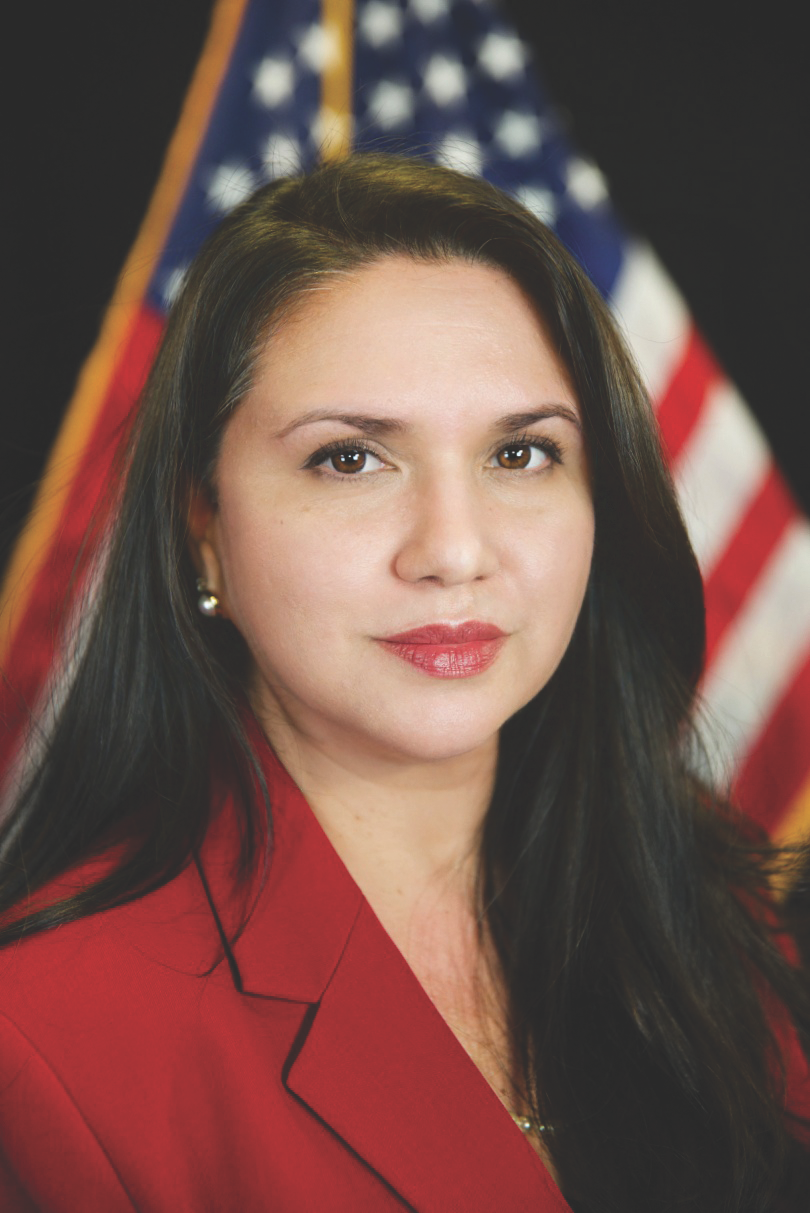
Sandra Mayoral Pedroarias
Senior Policy Advisor
Sandra Mayoral Pedroarias joined NWBC as senior policy advisor in September 2019. In this role, she leads the development of the Council’s annual body of policy recommendations to the White House, Congress, and Administrator of the U.S. Small Business Administration. Sandra brings to the Council more than fifteen years of policy, strategic communications, and federal government affairs experience.
Before joining the team, Sandra served as a consumer and business education specialist at the Federal Trade Commission where she instituted the agency’s first Hispanic outreach program. In 2004, Sandra was appointed director of outreach for the Office of Financial Education at the U.S. Department of the Treasury where she coordinated activities of the twenty-member Financial Literacy and Education Commission and was instrumental in helping develop and launch the first-ever National Strategy for Financial Literacy. She later served as senior advisor to the 42nd U.S. treasurer and was recognized with a Meritorious Service Award for her work as a policy advisor on financial literacy and currency education issues.
In 2007, Sandra was appointed deputy director of the Office of International Women’s Issues, Democracy and Global Affairs at the U.S. Department of State. There, she served as the office’s chief of staff, a key department liaison on women’s issues, and oversaw delegation and implementation of signature international awareness initiatives.
Just prior to joining NWBC, Sandra partnered with several nonprofits and women-owned public affairs firms, serving as a strategic communications consultant working on various economic empowerment initiatives. During this time, Sandra also dedicated herself to caring for her parents, and later on, to raising her young twin sons.
Sandra earned a Bachelor of Arts in Political Science and a Bachelor of Science in Communications from the California State Polytechnic University at Pomona, and a Juris Doctor from the Columbus School of Law at the Catholic University of America in Washington, D.C.

Jordan Chapman
Communications
Specialist
Jordan Chapman joined the NWBC team in February 2022. She currently serves as NWBC’s communications specialist, leading the Council’s external engagement and internal communications.
Prior to joining the team, Jordan interned in two of the three branches of government, assisting with communications in the Office of Surface Mining Reclamation and Enforcement and serving as a press intern with the House Judiciary Committee. In the interim, she volunteered on a presidential campaign by supporting expansion communications in the lead-up to the election. Both as a student and a professional, Jordan has lent a hand on a voluntary basis to multiple nonprofits, including Appalachian Voices and her state’s chapter of the Sierra Club.
A double hoo, Jordan received her Bachelor of Science in Environmental Science in 2019 from the University of Virginia before completing her Master of Public Policy there the following year.
Jordan is determined to help make the voices of others heard through creative content, outreach, and clear communications. This interest is what led Jordan to NWBC. Outside of the office, Jordan loves British television, French cinema, Spanish racing drivers, and her dog, Sadie.
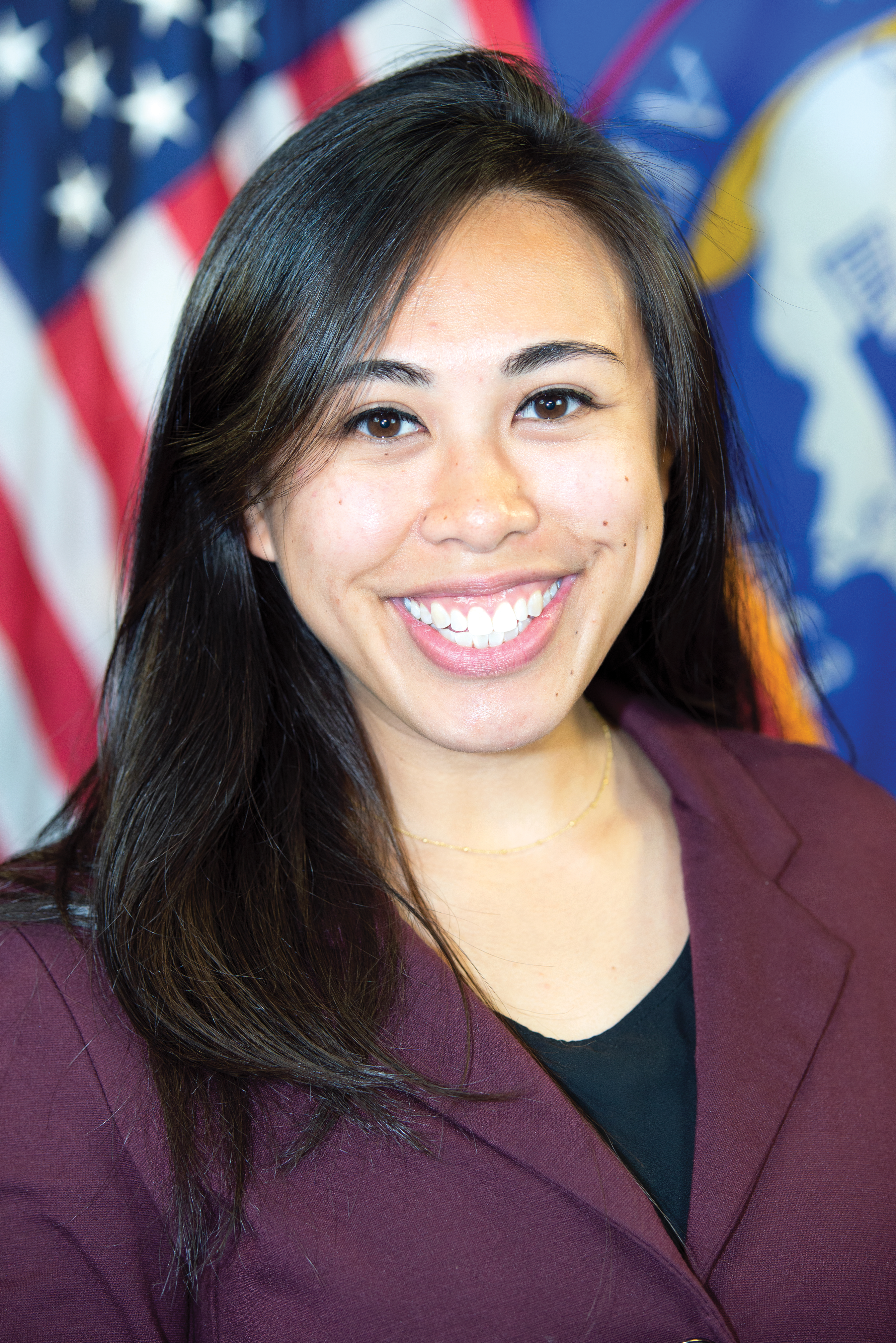
Ariana Satina
Program
and Operations Manager
Born and raised in Virginia and currently residing in D.C., Ariana Satina considers herself to be a D.C.-Maryland-Virginia (DMV) native. She was brought up by hard-working, small businessowning Filipino parents who turned their American dream into a reality and instilled their values in their daughter.
Ariana followed her own dream to learn more about the world by studying abroad. In 2018, she graduated from Franklin University Switzerland with a Bachelor of Arts in Communication and Media Studies and a minor in Psychology.
After graduating, Ariana hit the ground running to give back for all that she had received by volunteering as an outreach representative in the Visayas region of the Philippines. It was a transformative eighteen months that she attributes to her refinement.
Since then, she has implemented different aspects of her education and experiences. She has worked as a communications intern, a public relations and social media consultant, and a design assistant.
She currently works as the Council’s program and operations manager. Through her efforts, Ariana hopes to assist and advocate for female and minority small business owners.
Outside of work and responsibilities, Ariana thoroughly enjoys experiencing and savoring as much of the world as possible through travel, food, music, and friends. Life is meant to be lived and learned from, and Ariana aims to do just that.

Sara Torres Inda
Policy
Fellow
Sara is currently a graduate student at Carnegie Mellon University (CMU), harnessing her tech, management, and public analysis skills to apply them in her public service career. As NWBC’s Policy Fellow, Sara has assisted with coordinating meetings between NWBC and SBA stakeholders, researching relevant legislation, drafting brief documents, assisting with internal and external communications, and contributing to the advancement of policy recommendations.
Originally from the Sonora-Arizona region, Sara is passionate about giving back to the community in a diverse range of ways. She served as an instructor to refugee women in advancing their entrepreneurial independence through an introductory math literacy class and worked as a Youth and Outreach Specialist at Goodwill Industries, where she built partnerships to create a college readiness workshop for underserved youth in Arizona.
Sara enjoys reading, cooking, and going for walks around the Washington monuments and memorials to reflect on her roots, her journey so far, and her future ahead.
Recognition of service
Staff
Ana Argueta
Program
and Operations Manager
Eryka Warren
Intern
Staff
Barbara Kniff-McCulla
Jessica Flynn
Marygrace Sexton
Monica Stynchula
Nicole
Cober
Rebecca Hamilton
Sandra Robert
Shelonda Stokes
Vanessa Dawson

